
- Recommended
- Project Management
- Resource Management
- Professional Services
- Engineering projects
- Software Ratings
- Product News

Responsibility Assignment Matrix (RAM): definition, template, and examples
Have you ever been caught in a project where tasks slip through the cracks or team members aren‘t clear on who‘s in charge? This is a common hurdle in project management, but it doesn‘t have to be. The Responsibility Assignment Matrix (RAM) is a game-changing tool that brings order to the chaos. RAM ensures that everyone knows their role and projects run smoothly by clearly defining who is responsible for each task, who makes the final call, and who needs to be kept in the loop.
In this article, we‘ll see how RAM can help you overcome confusion, improve team collaboration, and keep your projects on track from start to finish.
What is a Responsibility Assignment Matrix (RAM) in project management?
A Responsibility Assignment Matrix (RAM), also sometimes referred to as a resource assignment matrix, is a project and resource management tool that helps you define the roles and responsibilities of your team members for each task or deliverable within a project. Also known as a RACI Matrix (where RACI stands for Responsible, Accountable, Consulted, and Informed), the RAM is a simple grid that maps tasks on one axis and team members or roles on the other. By filling in the matrix, you clarify who is responsible for executing tasks, who is accountable for ensuring they are completed, who needs to be consulted before decisions are made, and who should be kept informed throughout the process.
Types of Responsibility Assignment Matrix (RAM)
This structured approach is invaluable in complex projects, where clear communication and understanding of roles are essential to avoid bottlenecks, overlapping responsibilities, and missed deadlines.
The Responsibility Assignment Matrix (RAM) comes in several variations, each designed to fit different project needs and organizational structures. While the core purpose remains the same–defining and assigning responsibilities–different types of RAMs allow for flexibility depending on the complexity of the project or the level of detail required. Let‘s take a look at the most common types of RAMs.
RACI Matrix :
- Responsible : The person or team responsible for completing the task.
- Accountable : The individual ultimately answerable for the task’s completion. There should only be one accountable person per task.
- Consulted : Those whose opinions are sought (subject matter experts, for example) before a task is completed.
- Informed : People who are kept up-to-date on progress, but do not need to be consulted or directly involved.
Example: A company running a new product launch campaign can use a RACI Matrix to assign roles. The marketing manager (A) is accountable for the overall success of the campaign, while the content team (R) is responsible for creating promotional materials. The legal team (C) is consulted for compliance with advertising regulations, and the CEO (I) is kept informed of key campaign milestones.
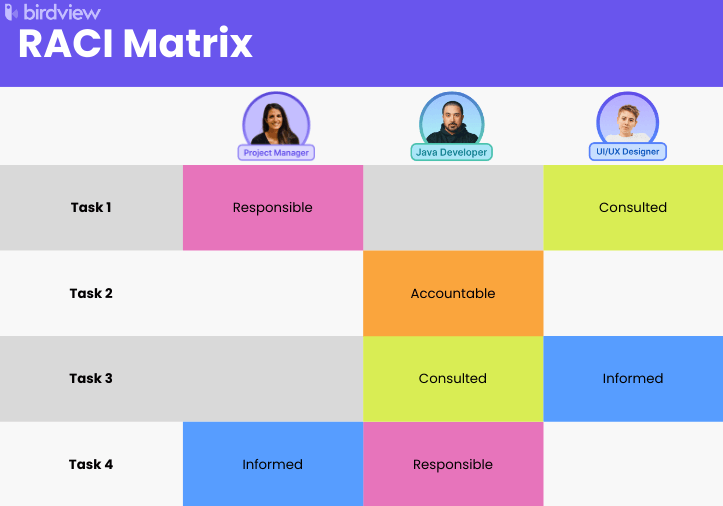
RASCI Matrix :
- Adds Support : The role that provides resources or assistance to the person responsible.
Example : In a software development project, the lead developer (A) is accountable for delivering the final product. Junior developers (R) are responsible for writing the code, while the UI/UX designers (S) support the process by providing design resources. QA testers (C) are consulted during the testing phase, and the client (I) is informed of progress.
CAIRO Matrix :
- Includes Omitted : Roles or individuals who are intentionally excluded from a particular task or decision.
Example : In a construction project, the project manager (A) is accountable for overseeing all stages. The structural engineer (R) is responsible for designing the foundation, while the architect (C) is consulted on the overall design. The electrical contractor (O) is omitted during the foundation stage but will be involved later. The local government (I) is kept informed about permits and inspections.
Responsibility Assignment Matrix benefits
Implementing a Responsibility Assignment Matrix (RAM) can make a significant impact on the way your project team operates. Whether your project involves a few individuals or multiple teams across different departments, a resource assignment matrix brings structure and clarity to task delegation, helping you avoid common pitfalls like missed deadlines, unclear responsibilities, and inefficient resource allocation. Here are some of the key benefits of using RAM in your project:
- Clarity and transparency
A RAM provides a clear understanding of who is responsible for each task, eliminating ambiguity. Everyone knows their role, which helps streamline decision-making and prevents misunderstandings about who owns a specific task.
- Improved communication
By mapping out who needs to be consulted or informed, a resource assignment matrix ensures that the right people are involved in discussions, reducing unnecessary communication and ensuring that key stakeholders stay in the loop at the right times.
- Enhanced accountability
With a designated person accountable for each task, the RAM ensures that there‘s a clear point of contact for progress updates and issue resolution. This creates a sense of ownership, helping tasks move forward without unnecessary delays.
- Efficient resource allocation
The RAM helps you allocate tasks based on team members’ roles, expertise, and availability. This prevents overallocation or misallocation of resources and helps you ensure that work is assigned to the right people.
- Reduced risk of overlap or gaps
By outlining each person‘s responsibilities, a resource assignment matrix minimizes the risk of work being duplicated or, worse, tasks being overlooked. This leads to a more efficient workflow and reduces the likelihood of last-minute surprises.
How to create a Responsibility Assignment Matrix
Creating a Responsibility Assignment Matrix is a straightforward but critical process for ensuring the success of your project. A well-constructed RAM provides a clear, visual representation of roles and responsibilities, helping your team understand who is responsible for each task, who has the final say, and who needs to be consulted or informed.
While creating a RAM may seem simple, attention to detail is crucial in ensuring that every task and role is accurately defined. Below is a step-by-step guide to creating a resource assignment matrix that will keep your project organized, on track, and aligned with its goals.
- Identify project tasks : Start by listing out all the tasks, deliverables, or milestones that need to be completed. These should be the key activities required to achieve the project‘s goals.
- Determine roles or team members : Identify the individuals or roles involved in the project. Depending on the size of the project, this might include project team members, external stakeholders, or departments.
- Assign responsibilities : Using the chosen RAM framework (e.g., RACI), assign the appropriate responsibilities for each task. Make sure there is one accountable person for each task and clarify who needs to be consulted or informed.
- Review and validate : Once the matrix is filled out, review it with the team to ensure everyone agrees with their roles and responsibilities. This step ensures that no roles are missed and that there is a clear understanding across the board.
- Update regularly : As the project evolves, so will the responsibilities. Make sure to update the RAM to reflect changes in the project scope, team composition, or responsibilities to keep it accurate and relevant.
Responsibility Assignment Matrix template
To help you get started, here‘s a simple template for a RACI Matrix. You can customize this template to fit the needs of your project.

Download RAM template
Responsibility assignment matrix example
Case study 1: how a raci matrix was used in a software development project.
In a mid-sized software development project, the team used a RACI matrix to streamline the development and deployment of a new application. The project had several critical phases, including requirements gathering, coding, testing, and deployment.
- Requirements gathering : The business analyst was responsible (R), with the project manager accountable (A). Developers were consulted (C) for technical feasibility, and the client was kept informed (I).
- Coding : Developers were responsible (R) for writing the code, with the lead developer accountable (A). The QA team was consulted (C) to ensure testability, and the project manager was informed (I) of progress.
- Testing : The QA team took responsibility (R), with the lead developer accountable (A). Developers were consulted (C) to fix issues, and the project manager and client were informed (I).
- Deployment : The DevOps team was responsible (R) for deployment, with the project manager accountable (A). The QA team was consulted (C) for post-deployment checks, and all stakeholders were informed (I).
This matrix helped the team avoid miscommunication, ensured everyone knew their role, and kept the project on track.
Case study 2: How a RACI matrix was used in a construction project
In a small office renovation project, a RAM was used to effectively manage the coordination between the key stakeholders and ensure the project was completed on time and within budget.
- Design and Layout : The interior designer was responsible (R) for creating the office layout and design, with the project manager accountable (A) for overseeing the project. The office manager was consulted (C) to ensure the design met the company‘s functional needs, while the contractor was informed (I) about the final design plans.
- Material Procurement : The contractor was responsible (R) for procuring materials needed for the renovation, with the project manager accountable (A) for budget adherence. The interior designer was consulted (C) to ensure the materials matched the design specifications, and the office manager was informed (I) of progress.
- Construction and Execution : The contractor was responsible (R) for executing the renovation, with the project manager accountable (A) for ensuring the project stayed on schedule. The interior designer was consulted (C) during the renovation for design adjustments, and the office manager was informed (I) of the project‘s progress.
This RAM ensured that each stakeholder’s role was clearly defined, reducing the risk of miscommunication and keeping the project on track.
How to manage resources and their responsibilities with Birdview
Using a Responsibility Assignment Matrix (RAM) is a proven method for bringing clarity, accountability, and efficiency to any project. By defining who is responsible, accountable, consulted, and informed for each task, you can avoid confusion, streamline communication, and ensure smoother project execution. Whether you’re managing a complex software development project or coordinating teams on a construction site, a resource assignment matrix can be an invaluable tool for ensuring success.
However, creating and maintaining a RAM can become challenging, especially in larger projects with many moving parts. This is where advanced project management tools like Birdview project and resource management software come into play. Birdview not only helps you to track resources, monitor task progress, and ensure that responsibilities are aligned with capacity and availability. With Birdivew, you can enhance your project planning, manage resources more effectively, and keep your team on track–all in one platform.
Birdview streamlines the process by offering a suite of advanced functionalities tailored to make resource planning and management simpler, smarter, and more efficient. With Birdview, you get:
- Real-time resource tracking
Birdview allows you to monitor resource availability and utilization in real time, ensuring that tasks are assigned to the right people based on their current workload and capacity.
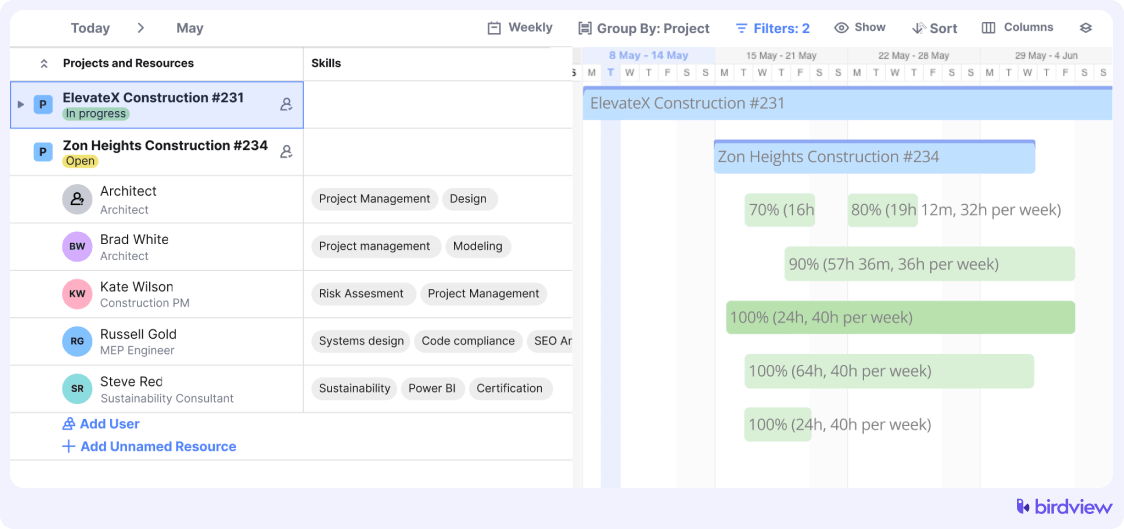
- Comprehensive project visibility
With Birdview‘s intuitive dashboards, you get a holistic view of your project progress, including who‘s working on what, task statuses, and potential bottlenecks.
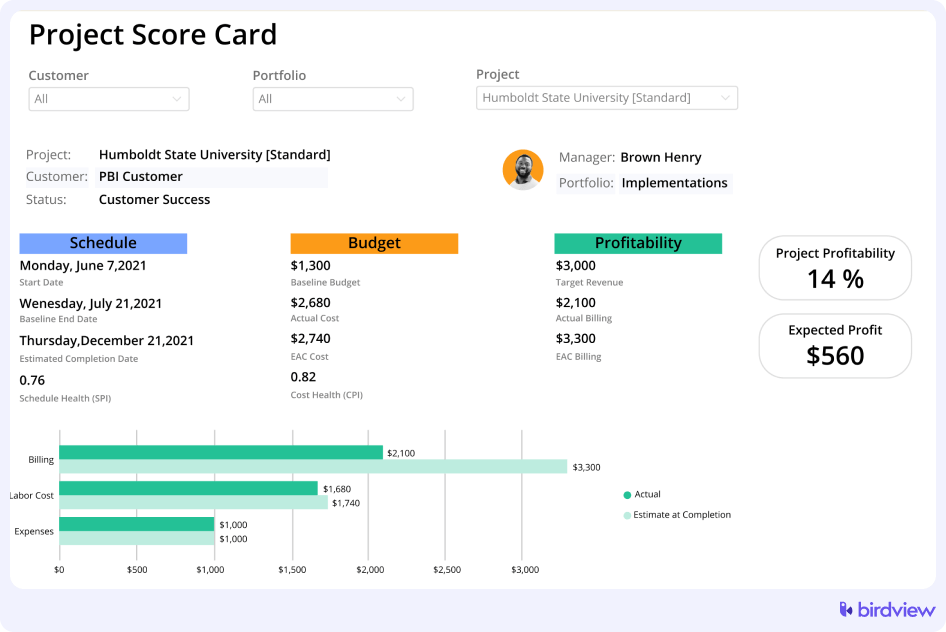
- Role-based resource allocation
Birdview helps you allocate resources based on skills, roles, and availability, ensuring the right team members are assigned to the right tasks. With its AI-powered resource suggestion feature, Birdview goes a step further by recommending the best staff options for each task, taking into account their expertise and current workload.

- Capacity planning
Birdview‘s capacity planning tools help you forecast resource needs and plan ahead to avoid overloading your team or underutilizing key personnel.
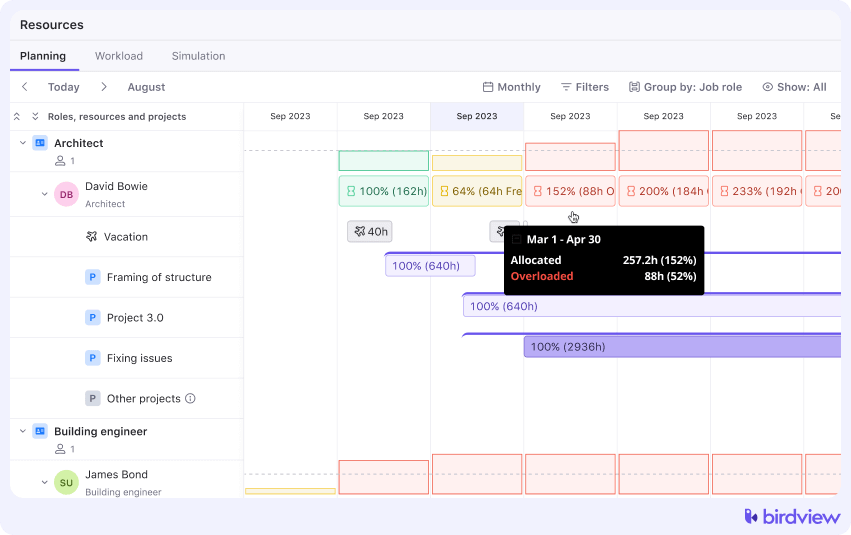
- Collaboration tools
Integrated communication features make it easy to consult and inform stakeholders, ensuring that everyone stays on the same page throughout the project lifecycle.

Explore how Birdview can fit your needs. Sign up for a free trial to test the platform yourself, or schedule a demo where a dedicated manager will guide you through the features and help you get the most out of the software.
Try Birdview PSA for free
Related Posts
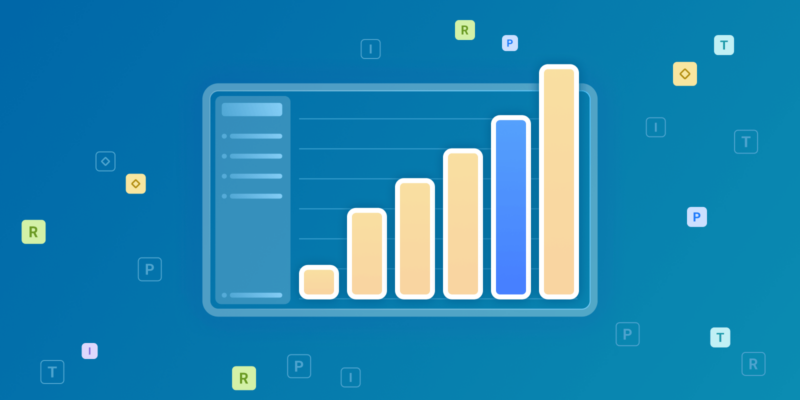
How to create a resource breakdown structure

Managing resource constraints in project management: types, strategies, and tips

Top 18 MS Project alternatives 2024

We'll contact you to provide our pricing shortly
Birdview is the best option for your needs
It looks like we need to figure out a custom solution for you. Let’s book a quick 15-min call with Birdview’s Product Specialist
For internal teams seeking to enhance their project management and collaboration
For professional services companies aiming to streamline their entire delivery
Your 14-day trial is ready! Explore Birdview's full potential by scheduling a call with our Product Specialist.
Get access to your account from here or check your inbox.
We've sent an activation link to email. Check your inbox!
Please contact us if you need any assistance.
Toll-free phone: +1-888-261-9878
I understand, thank you
By continuing to use our site, you agree that we can place cookies. Learn more .

Free Project Management Templates
RACI Chart Template
The RACI chart is used in project management to assign roles and responsibilities in the project. It is a responsibility matrix which assigns roles according to the following four categories; Responsible (R), Accountable (A), Consulted (C), and Informed (I). A RACI chart is an effective tool for ensuring clear communication throughout the life of a project, as such it is used by most successful project managers.
Download Template
Using a RACI chart template means your path to a smoother project management experience can start right now. If you aren’t familiar with RACI yet, take a few minutes to read on.
What Does RACI Mean?
RACI is an acronym for Responsible, Accountable, Consulted, and Informed. The term is used in regard to a RACI chart, which uses these four components to assign and track tasks involved in a project plan. A RACI template makes creating a chart easier, especially if you are new to the process.
What is a RACI Chart?
A RACI chart is also known as a Responsibility Assignment Matrix. That sounds rather technical, but simply speaking, it is a tool to clarify specific roles and responsibilities within a team. When everyone can see the big picture and their place in it, the project runs more smoothly. The chart improves communication and facilitates decision-making, thereby improving efficiency and accountability.
What Are the 4 Responsibility Roles in a RACI Chart?
There are four roles in a RACI chart, represented by each letter in the RACI acronym. These components are Responsible (R), Accountable (A), Consulted (C), and Informed (I). The designations are used to reflect a person’s involvement regarding a specific task on a project.
Responsible (R): An R on the chart means this is the person responsible for getting the job done. The particular task may involve multiple team members, but a specific person should be held responsible for making sure the job is completed. Think of it as, “the buck stops here.”
Accountable (A): This person is accountable for making sure the whole team has the resources it needs to complete the task and that the job is done correctly . This is more of an executive management role.
Consulted (C): The person or group with a C designation is the “go to” if a situation arises that requires more expertise or a decision. They are usually subject matter experts and have experience that is valuable to the task at hand. Communication with a consulted person is always a two-way communication.
Informed (I): The Informed people are kept informed of the progress of the task, or perhaps only at the completion of the task. Communication is one way. The informed person is kept in the loop but does not provide feedback. Be sure to include the right people in your organization which should be informed.
Fully understanding the four RACI roles will help you assign them to the appropriate person. That’s important because when there is clarity amongst the team and stakeholders, there is more efficiency overall.
What Is a RACI Chart Used For?
RACI charts are particularly useful for complex projects, which is why they are so popular in project management. Not only do they improve communication, but they also help to reduce confusion and make sure there is no overlap in tasks.
In addition to project management, RACI charts are also widely used for large projects in a variety of environments such as in businesses, government, educational institutions, healthcare, and service industries. Whether a project manager, or a business owner, any situation where there are multiple tasks to be completed by multiple people is a good opportunity to use a RACI chart.
How Is RACI Used in Project Management?
Typically, in the world of project management, the project manager creates the RACI chart at the beginning of a project to define the roles and responsibilities. Otherwise, multi-faceted projects can develop a variety of problems such as duplicated work or delays to the timeline.
This type of chart gives everyone a few from 10,000 feet. Team members and stakeholders alike can see the entire view—everything that needs to happen in the different project phases and who is involved in making it happen.
The RACI diagram serves as a reference for the project manager throughout the lifecycle of the project. It can be updated as needed to reflect changes in roles or responsibilities and using a RACI matrix is considered best practice in project management.
Advantages of a RACI Chart
Using a RACI chart helps utilize best practices that results in several advantages to a team or organization. In addition to clarifying responsibilities, it can also streamline processes and ensure deadlines are met and quality standards achieved.
- Clarification: A RACI chart clearly states who is expected to do what job and when. When everyone can see their place in the process and who is fulfilling each role, it reduces confusion and improves efficiency.
- Better Communication: A RACI chart provides a clear framework for communication. Team members know who to contact with an issue and that reduces the risk of misunderstandings.
- Increases Accountability: Clearly assigned roles increases accountability among team members. It helps to ensure that tasks are completed in accordance with quality control standards and on time.
- Decision-making: When team members have an issue or need a decision, they’ll know exactly who to contact. This ensures the right person is consulted and that a decision is made in a timely fashion.
- Efficiency: When everyone has a clearly defined role and they know who to contact if there is a problem, it improves efficiency and reduces the risk of delays or bottlenecks.
- Better Project Management: A RACI chart can be an effective project management tool, helping to ensure that tasks are completed on schedule and that the project stays on track.
When to Use a RACI Chart
A RACI chart should be used in situations where there are multiple people or teams involved in multiple tasks. In project management, a RACI chart should be used throughout the project.
The following are examples of when you might use a RACI Chart:
- When planning and executing a complex project with multiple stakeholders and different roles.
- When rolling out a new process or system within an organization.
- When delegating tasks or responsibilities within a team and designating a responsible party.
- When managing interdepartmental projects or initiatives.
- When defining roles and responsibilities for a series of tasks and deliverables.
- When analyzing and streamlining business processes.
- When making decisions that involve multiple people or departments.
- When establishing clear lines of communication and accountability within a team or organization.
Agile Project Management and RACI
You may be wondering if you can use a RACI Chart in an agile project management environment? The answer is yes!
However, it is important to note that defined roles and responsibilities may have to be more fluid for agile project management. The team may need to adapt and adjust to changing circumstances.
In this case, the RACI chart should be viewed as a guideline rather than a hard and fast rule. Meaning, team members may need to take on different project roles or responsibilities as the project progresses.
Common Pitfalls of RACI and How to Avoid Them
While a RACI chart can be a useful tool to ensure the smooth execution of a project, there are also several pitfalls to be aware of.
Common pitfalls of RACI and ways to avoid them:
- Lack of Defined Roles: It is important to clearly define the roles and responsibilities of each person in a RACI chart to avoid confusion. It is also important to make sure that everyone understands their role and the tasks that are expected of them.
- Overlapping Roles: Make sure that no two roles overlap. If multiple people are responsible for the same task, it can lead to confusion and delays.
- Lack of Commitment : A RACI chart is only effective if everyone involved in a task or project is committed to following it. Involve relevant stakeholders in the creation of the chart to help ensure they are committed to following it.
- Lack of communication: Check in regularly with team members to track progress and make sure everyone is aware of their roles and responsibilities.
These tips will help you have a successful project in the end.
How to Make a RACI Chart in Excel
Creating a RACI chart in Excel is quite easy and can be done using the built-in tools and functions in the program. However, if you don’t want to go through the process of creating one from scratch, we have a pre-made, RACI chart template available for download in Microsoft Excel format.
This free template is free to use and can save you time and effort in creating your own RACI chart. Simply download the template, input your tasks, and team members, and you’ll have a fully functional RACI chart in no time. This can be a particularly useful option for teams or organizations that need to create multiple RACI charts on a regular basis. You can download our free RACI matrix template by clicking the orange “ Download Template ” button at the top of this page.
If you want to create your own chart from scratch, the following is a step-by-step guide to creating one in Excel:
Open a new blank workbook in Excel.
- Create a table with four columns: Task , Responsible , Accountable , and Consulted/Informed .
- In the first column, list all the project tasks that need to be completed.
- In the Responsible column, list the names of the people or departments who are designated as the responsible person for completing each given task.
- In the Accountable column, list the name of the accountable person or department who is responsible for the correct completion of that task.
- In the Consulted column, list the names of the people or departments who need to be consulted or informed about each task.
- For the Informed column list those who need to be kept informed for each task. These people will receive one-way communication from the responsible team member.
- If necessary, you can separate the above section into two columns—Consulted and Informed—to clearly distinguish between these two roles.
- Once you have completed the table, you can add formatting and design elements to make your RACI chart more visually appealing.
- Save the workbook and share it with your team to ensure that everyone has access to the RACI chart.
By following these steps, you can create a fully functional RACI chart in Excel.
Online Tools to Create RACI Charts
You may already be aware that there are several online tools that you can also use to create RACI charts. These tools often provide a range of features and templates to help you create a professional-looking RACI chart quickly and easily. Some popular online tools for creating RACI charts include:
Lucidchart : This tool allows you to easily create RACI charts online. Lucidchart allows a project team to collaborate in real time and share RACI charts with the project team.
creately : creately is another popular online tool for creating visual workspaces and has the ability to create RACI matrixes which are easily shared within a project team.
Monday.com : Monday.com is a popular tool for project management which also has the ability to create online RACI charts. Monday.com has a built in RACI template.
By using one of these online tools, you can easily create a RACI chart without the need for specialized software or design skills. You may also want to look at your project management software to see if it has the ability to make RACI charts already in it.
What Can I Use Instead of a RACI Chart?
If you are looking for an alternative to a RACI chart, there are several options that you can consider. Some common alternatives include:
- (Expanded) Responsibility Assignment Matrix (RAM): A RAM is similar to a RACI chart, but an expanded version can include additional roles such as Reviewer and Support. This can be useful for teams that need to clearly define more complex roles and responsibilities.
- Influence/Impact Matrix: This is a tool that identifies the level of influence each stakeholder has on a project or decision. It is useful for teams that need to understand how these relationships affect the project.
- Role and Responsibility Chart: A Role and Responsibility chart is similar to a RACI chart, but it is more focused on defining the roles and responsibilities of individuals within an organization. It’s useful when this needs to happen on an ongoing basis.
- Flowchart: A flowchart is a graphical representation of a process or system. It is useful for visualizing the steps involved in a task or project and to understand the relationships between different components.
The best chart for your project will depend on the specific needs of your business or project.
Final Thoughts on RACI Charts
The format of a RACI chart sets up clear expectations for team members and stakeholders. That improves communication and efficiency, making it much more likely you’ll keep everyone in the loop and hit your deadlines for project deliverables.
Use our free excel template, and your job just got a little easier! Simply click on the button marked “ Download Template ” at the top of the page and start right now.
How to Make a Responsibility Assignment Matrix: Excel RACI Template
What is a responsibility assignment matrix?
How to create a responsibility assignment matrix in excel, free raci template for excel, how to manage raci roles in your teamgantt plan.
A responsibility assignment matrix (RAM) is a tool used in project management to clarify team and stakeholder roles for each project step. It paves the way for smooth collaboration by ensuring everyone knows what they need to do, who they need to talk to, and who has the final say on key decisions and deliverables.
RACI—which stands for Responsible , Accountable , Consulted , Informed —is the most popular framework used for assigning roles and responsibilities on projects. Here’s a quick breakdown of RACI categories in basic terms:
- Responsible : Who completes the work?
- Accountable : Who makes decisions?
- Consulted : Who provides expertise?
- Informed : Who needs status updates?
Of course, RACI isn’t the only responsibility assignment matrix out there. These RACI alternatives provide a small sample of other approaches you might come across in project management.
- RASCI (or RASIC) matrix : This RACI alternative adds one extra role into the responsibility assignment mix. In the RASCI model, the S stands for Supportive . While this role covers anyone who will lend the Responsible person a hand with the work, a Supportive team member isn’t responsible for the outcome.
- DACI matrix : DACI stands for Driver , Approver , Contributor , Informed and is used to outline decision-making roles and responsibilities for projects. In this framework, the project manager or leader typically serves as the Driver guiding the team to a decision.
- RAPID responsibility matrix : RAPID stands for Recommend , Agree , Perform , Input , Decide and is another decision-making framework used to define authority vs accountability. The Recommend role kicks things off by suggesting an action, while the Decide role has the ultimate say in how things move forward.
- CARS : CARS stands for Communicate , Approver , Responsible , Support . In this model, Communicate combines RACI’s Consulted and Informed roles into a single assignment. Someone with the Communicate role lends their expertise and needs to be kept up-to-date on progress. The Approver is the main decision-maker who calls the shots.
Lay a clear path to success with a visual plan that’s easy to understand, and keep everyone in sync with flexible workflows and team collaboration.
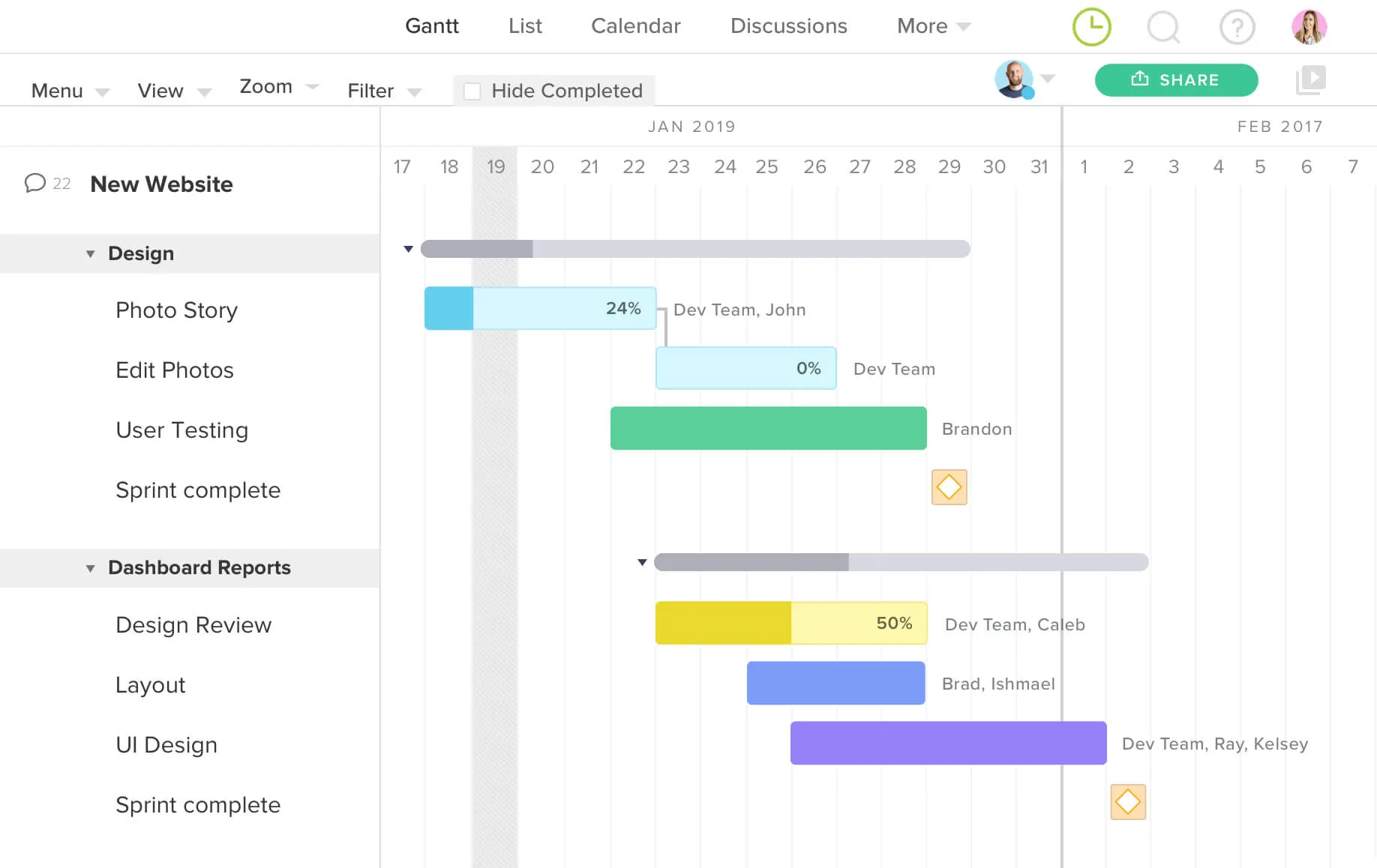
Lots of people use spreadsheets to make a responsibility assignment matrix for their projects, so let’s walk through the basic steps of building one in Excel, using the RACI framework as our model.
Looking for an online solution? See how TeamGantt's RACI feature integrates into your project plan.
1. List project tasks and deliverables in column A
First, make a list of all the work that needs to be done for your project down the left side of your matrix. Enter each project task, milestone, or decision in column A of your Excel worksheet.
Feel free to group tasks by project phase like we’ve done in the screenshot below. That way, your RACI matrix is easy to scan and read.
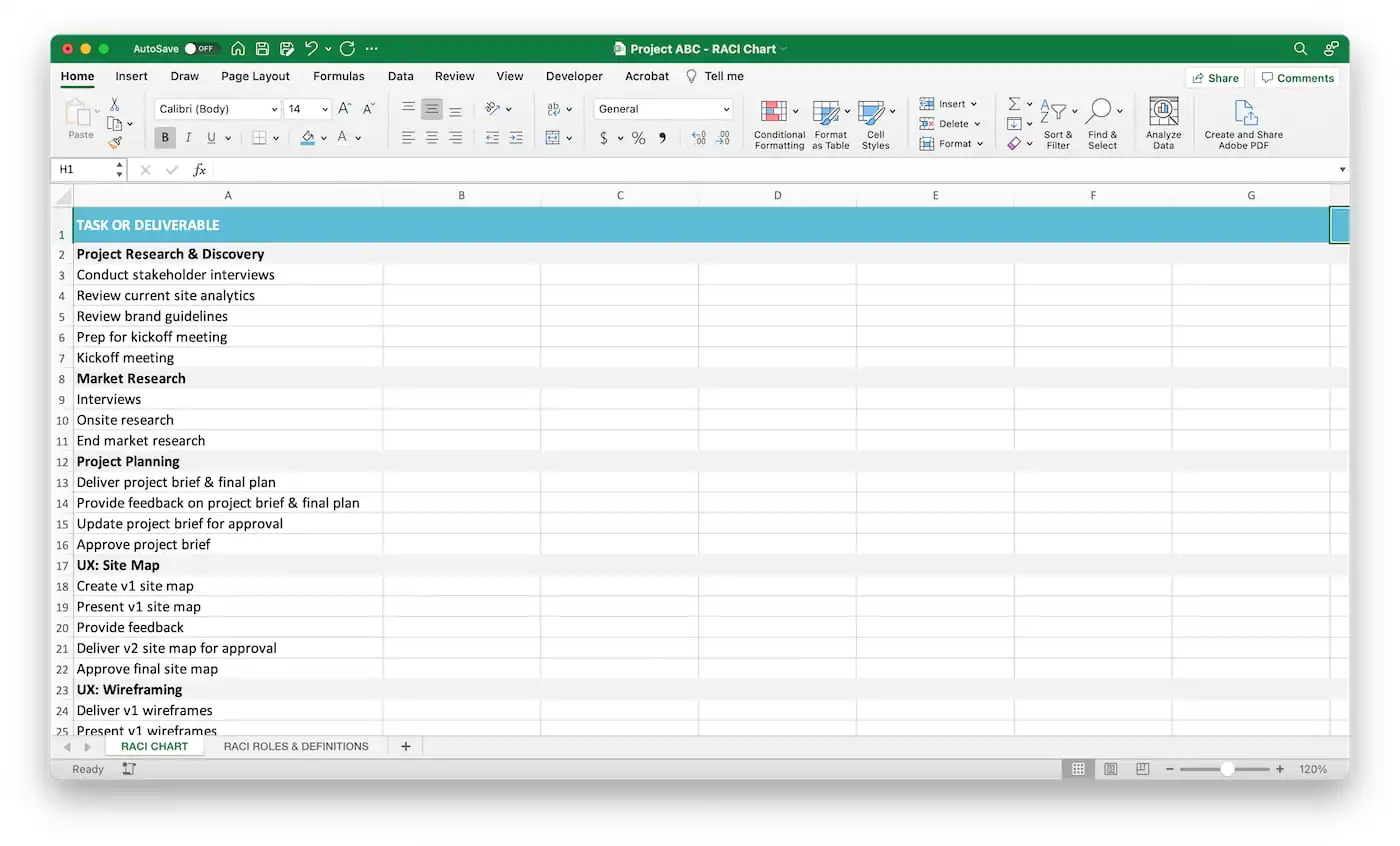
2. Add team members or project roles across row 1
Starting with column B, label each column header with the name of a team member and/or project role.
Include the people who will execute and review work for the project, as well as any subject matter experts or stakeholders you may need to consult or keep in the loop along the way.

3. Insert a new worksheet for roles and definitions
Click Insert > Insert Sheet from the Home ribbon at the top of your Excel workbook.

Go to your new worksheet, and list each letter of the RACI acronym in column A. Then enter the corresponding role for each letter in column B. We also included RACI definitions in column C as a handy reference for anyone who might need a refresher.

You’ll use this worksheet to populate a drop-down list on the main RACI matrix tab to make it easier to assign roles quickly.
4. Add a drop-down list of roles to your matrix
Now, go back to your main worksheet, and click into the first open cell in your matrix.
On the ribbon, click Data > Data validation to insert a drop-down list with RACI roles.
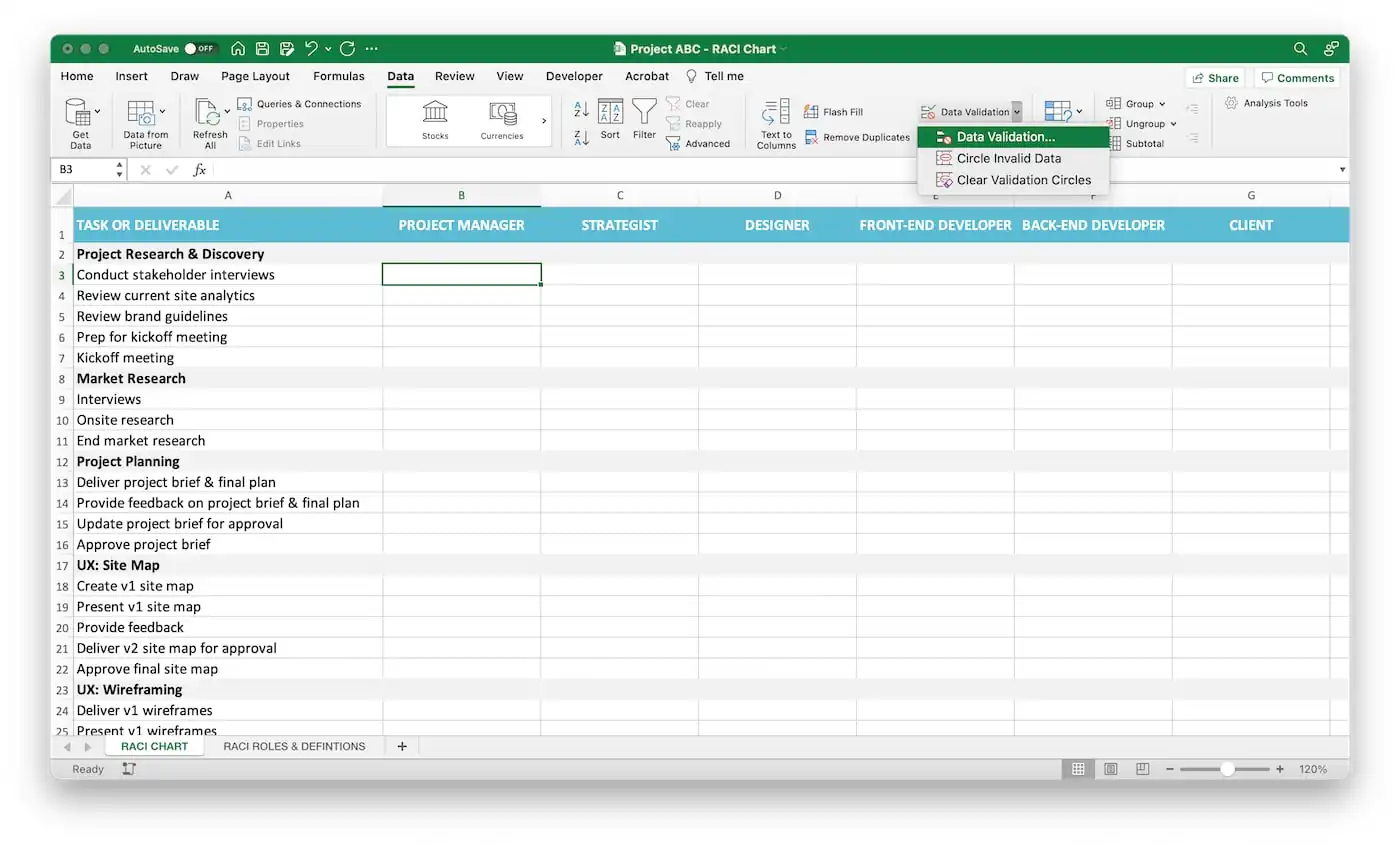
On the Settings tab, choose List under the Allow menu.

Click into the Source field, then highlight the data range with your options from the RACI Roles & Definitions worksheet you set up in Step 3. We highlighted cells A2-A5 in our example.
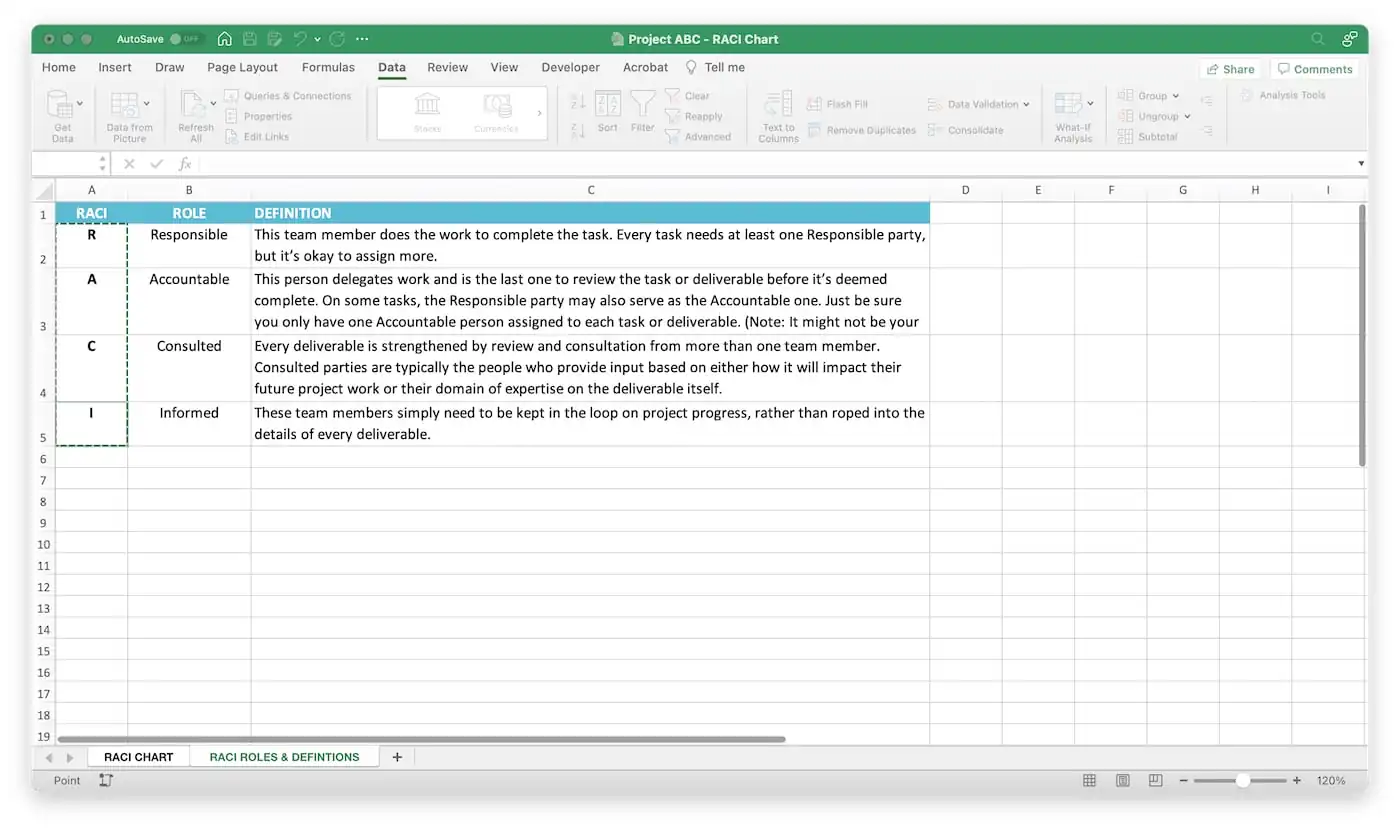
Verify your Data validation settings are correct, then hit Enter to add the drop-down list to your selected cell.
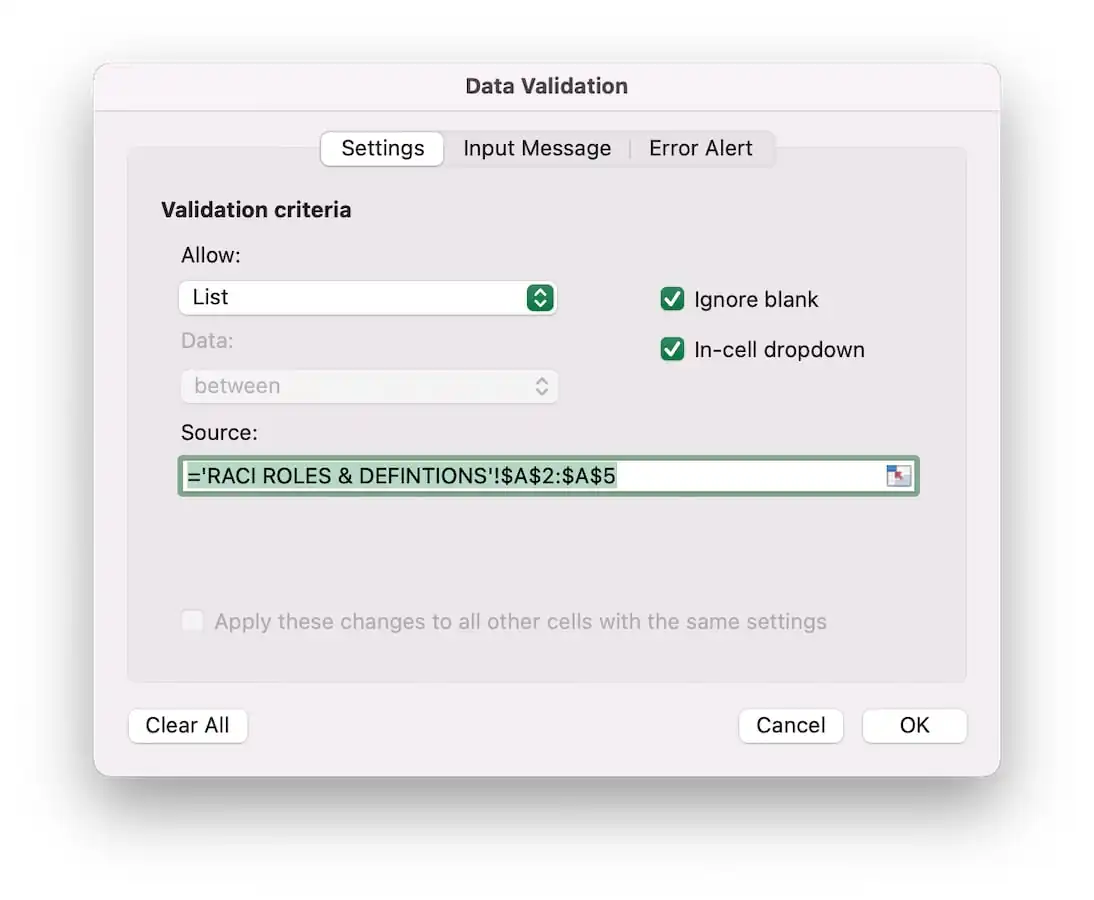
Copy and paste that cell to apply the drop-down list to other cells in your RACI matrix worksheet.
5. Color-code assignments with conditional formatting
Click Conditional Formatting > New Rule on the Home tab. Select Classic > Format only cells that contain > Specific text > containing . Enter the letter R in the text box, then choose Custom Format , and apply a background color (and any other styles you want).
Repeat this step for each additional letter in the acronym.
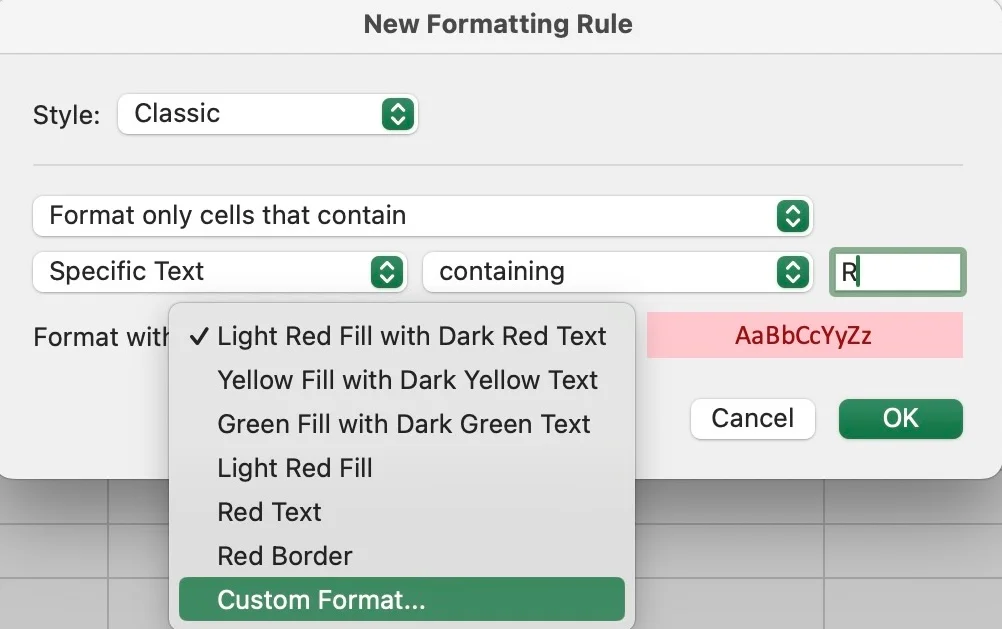
6. Assign a RACI value to everyone on every task
You’re almost there! Now go down the list of tasks on your responsibility assignment matrix, and assign a role to every person who will be involved in that project step or deliverable.

Want to build a responsibility assignment matrix of your own, but don't want to start from scratch? Download our ready-made Excel template for free. This blank RACI template is fully editable, so you can customize it for any project you manage.
We added drop-downs for assigning RACI roles more easily and included a RACI chart example tab as reference in case you need a little extra guidance.
Download: RACI matrix template for Excel
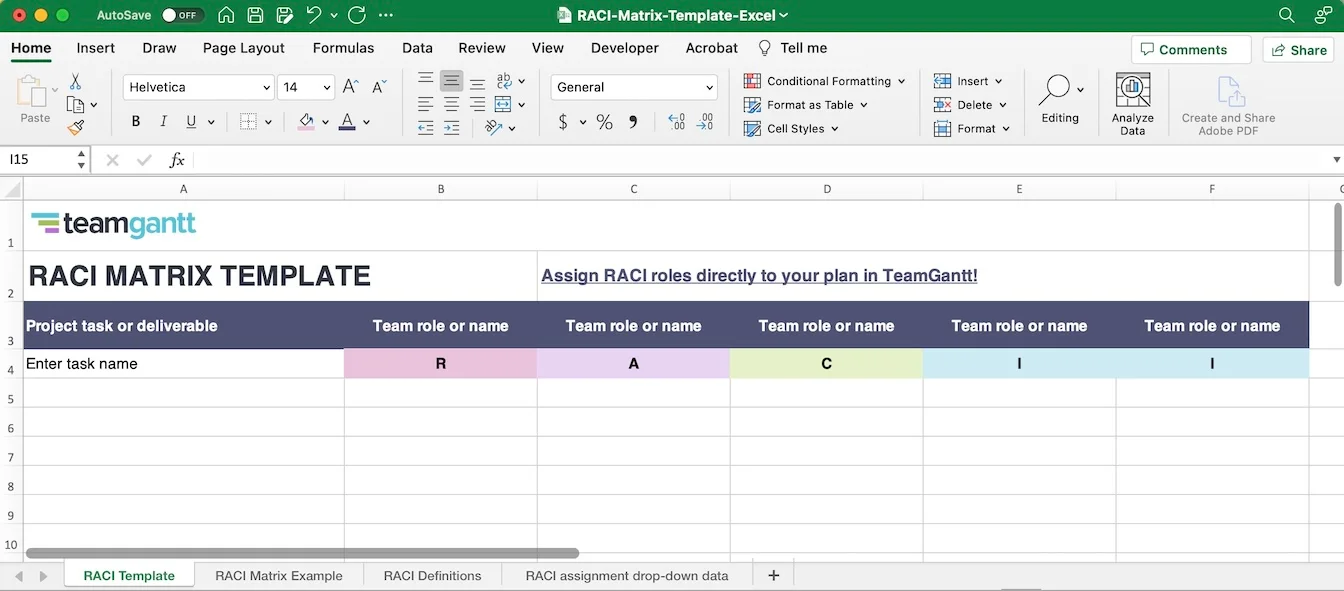
You can easily upload your final matrix to your TeamGantt project . But if you don’t want to worry about outdated spreadsheets that get forgotten once work begins, why not assign RACI roles directly to your plan?
Here’s how to use TeamGantt’s online RACI feature for your next project.
Assigning RACI roles and responsibilities to TeamGantt tasks
- Open your project, and toggle to the RACI tab. This will display all your project tasks in a list format (rows). On the right side of the matrix, you’ll see a column for each person currently invited to the project with cells for each task in the project.
- Click the cell below each person who needs to be assigned a role on a task, and choose one of the RACI options from the drop-down.

Viewing RACI matrix assignments for your project
There are 2 simple ways to view RACI assignments in TeamGantt:
- From the Gantt tab : If someone is assigned to a task and has a RACI role on that task, the RACI value will appear in parentheses next to that person’s name on the gantt chart. Just be aware that you won’t see RACI assignments for people who haven’t been assigned to a specific task in Gantt view.
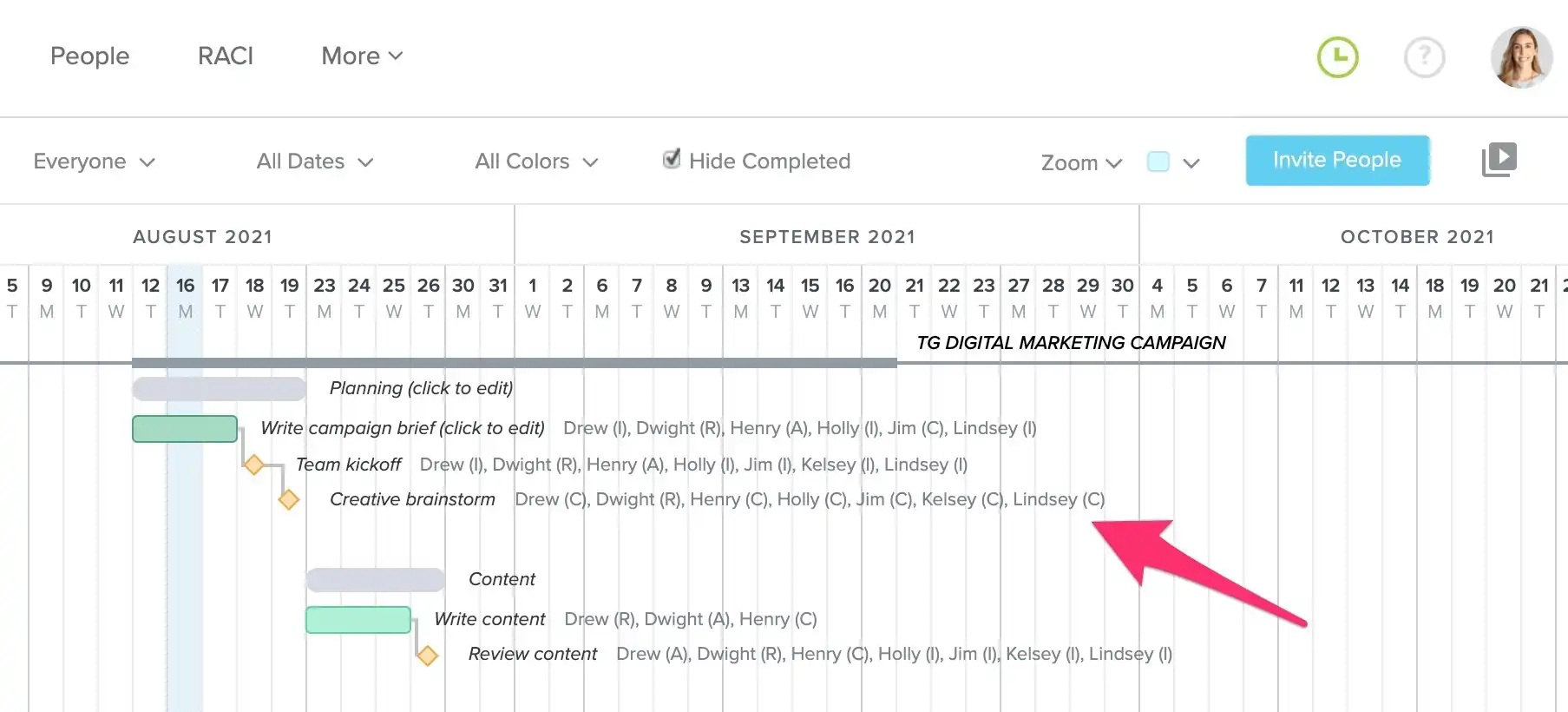
- From the RACI tab : To access your project’s full RACI matrix, simply toggle to the RACI tab for that project. You’ll find RACI assignments for every person playing a role—whether or not they’re the one responsible for doing the work.
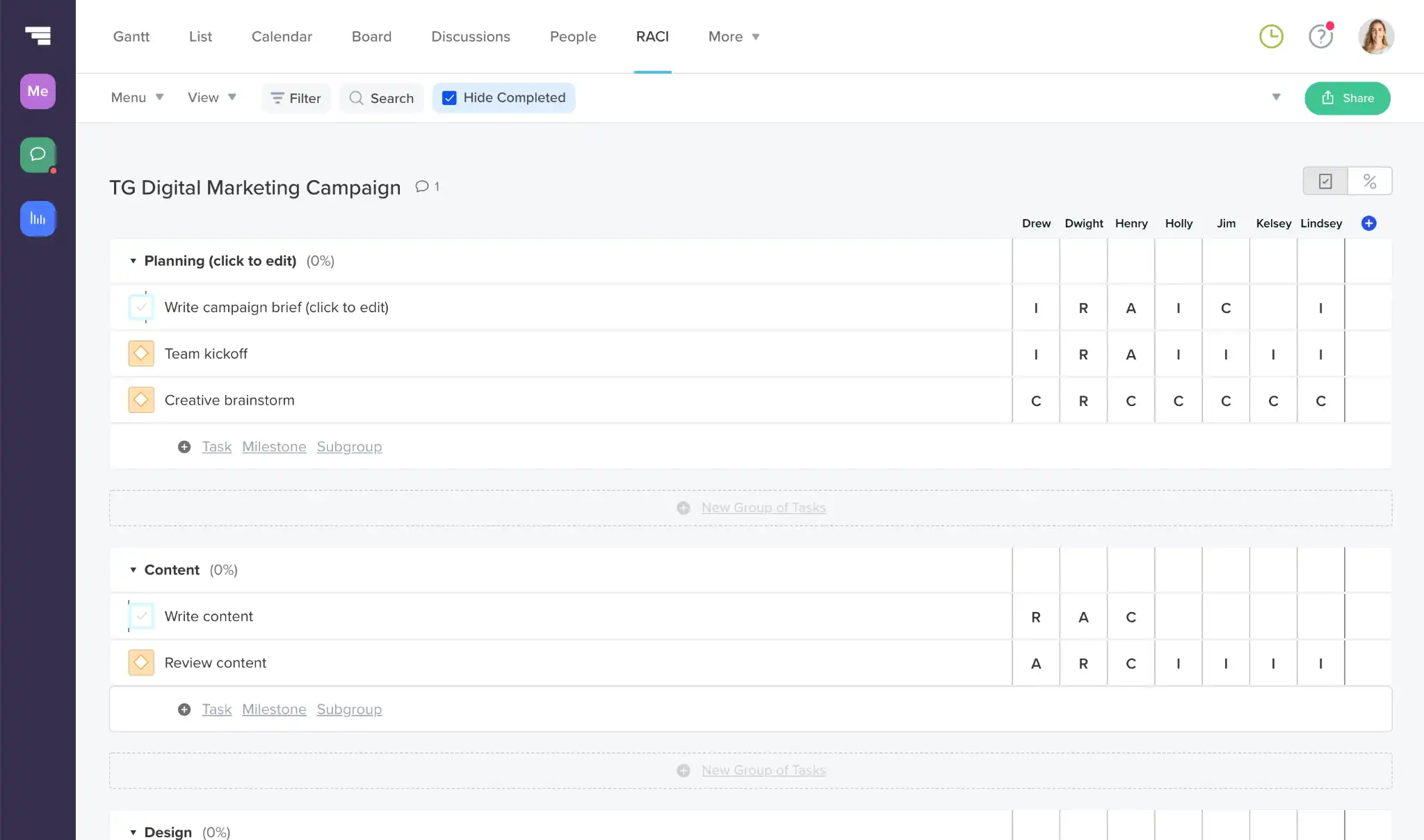
Keep teams in sync—and accountable—with TeamGantt
A responsibility assignment matrix is a simple tool that makes projects easier to manage by creating less confusion and more accountability. But you’ve got more than roles and responsibilities to keep straight.
TeamGantt makes it easy to build a project plan your whole team can contribute to and collaborate on. Everything happens online, so you can stay on top of deadlines and monitor progress in real time.
Use our built-in RACI chart to assign roles and keep them visible from project start to finish, so everyone knows how they contribute to success.
Try TeamGantt’s Pro Manager plan free for 7 days!

Filter by Keywords
Project Management
9 raci chart examples for project management.
September 7, 2023
Start using ClickUp today
- Manage all your work in one place
- Collaborate with your team
- Use ClickUp for FREE—forever
Not having project roles and responsibilities set in place leads to a myriad of project management-related issues—schedule delays, scaling costs, and lower performance, just to name a few.
That’s when the RACI matrix, also known as the RACI diagram or responsibility assignment matrix, comes into the picture. 🖼️
The RACI model helps with mapping all of the stakeholders’ roles and responsibilities, bringing structure and clarity, and engaging everyone from the team in the successful project delivery so that miscalculations are out of the question.
Here’s why many people from the corporate world across various industries, from healthcare to construction, swear by RACI charts . 🙏
What is a RACI Matrix Chart?
Advantages of the raci chart model, when to use the raci chart model, how to create a raci chart model, clickup examples, miro examples.
- Coda Examples
Who Benefits From Using a RACI Chart?
Raci is the way to go.
RACI matrix is a simple approach to defining project roles and responsibilities that help produce desired outcomes.
This term is an acronym that stands for Responsible, Accountable, Consulted, and Informed. RACI essentially describes the different roles assigned to team members involved in the project and details who does what.
Responsible : As you can already suggest, this person is responsible for taking action and ensuring that tasks on the project are being worked on.
Typically, this is a team member or a project manager that reports to an A. You can have more Rs in a RACI, and some of them can also be involved in the decision-making process .
However, it is highly advisable not to blow things up out of proportion and over-assign the number of Responsibles in your responsibility assignment matrix.
Accountable : That’s someone who ensures all the responsibilities are assigned properly, approves or rejects work or decisions (basically, this person is a decision maker), and ensures that everything is successfully and timely delivered. According to the RACI matrix, there should be only one A.
Consulted : This is the person the team consults about various topics and actions, an expert. This person, or multiple persons, provides feedback and evaluates so tasks can be performed.
Informed : Someone who should be updated on progress once everything is done and dusted but isn’t directly involved in the process. This person doesn’t contribute to making decisions or delivering tasks nor is consulted on any matter.
We know project management teams love abbreviations : PMP, KPI, SOW, and SME. The list goes on and on, but the RACI matrix chart makes it a breeze to scheme out key decisions, tasks, milestones , and roles.
When it comes to large project management teams, where team members are distributed across multiple departments and reliant on other teams, it is kind of natural to suffer from role confusion.
In a situation like this, it’s up to a project manager or the leading project team to step up and make sure that every member of every team is well aware of what’s expected from them. Things can get even more challenging if the work is remotely managed and done. However, that’s when the RACI matrix comes to the rescue! 🚀
The RACI chart model provides a myriad of benefits in this regard :
- It eliminates role confusion and confusion about who makes decisions (it could be that the Accountable or Responsible party is the decision-maker, so it should be made clear from the beginning)
- It encourages teamwork and communication between everyone involved in the project, which leads to setting expectations straight
- It prevents over and under-allocation of resources of a team member and ensures a smooth reallocation of resources when needed
- It can guarantee that even in case of resource reallocation, no task is overlooked
- By using it, you’ll streamline communications, eliminate conflict resolution, instill trust and ensure a high level of engagement
- Ultimately, it improves project efficiency and saves time
It’s worth mentioning that the RACI chart can ensure that every relationship is managed appropriately, whether it be with customers, sponsors, VIP clients, internal users, suppliers, investors, executives, analysts, or government regulators.
That’s why this model ticks all of the boxes for both B2B and B2C businesses. ✅
RACI matrix can be used for all-things-project-management, from clarifying team member roles and tasks to eliminating any sort of confusion and stalled processes.
The great thing is that it is unbelievably flexible, and you can use it no matter which industry you are in. 🤩
Here are some of the examples of when the RACI chart model can be helpful :
- Role confusion typically gets in the way of progress and bogs down the approval process or when decisions are made seemingly arbitrarily, again, because of the lack of transparency around the roles
- When authority, responsibilities, roles, and tasks are not clearly defined
- When there is no clarity on who should be performing tasks, which either results in multiple people working on the same task or none of them working on the project tasks they should be working on
As an example, any project manager or product owner is somehow (wrongfully) seen as responsible for every little detail and the success of a project team in general.
The RACI chart takes the burden of these roles. It allows developers and designers to be responsible for their scope of work .
However, note that RACI is not the one-size-fits-all solution.
It works wonders with larger, complex projects that involve multiple stakeholders. On the other hand, it simply doesn’t cut the mustard for smaller project management teams and fast-moving projects since it can only slow down the decision-making process and the project as a whole.
Before you actually start creating a RACI chart, take these factors into account :
- Ideally, one person should have only one type of responsibility
- The Accountable person should have the authority and be able to provide guidance and help with completing tasks
- Assign a single Accountable party per deliverable
- Every task should be associated with Responsible and Accountable roles while it is not mandatory to ask for outside input if the task is not overly complex
- Stakeholders should be informed even about minor changes and updates on the project
Now, here’s how to create a RACI chart:
1. define deliverables.
Define and list the main project tasks that need to be completed and list them all on the left side of the RACI chart, one under another.
Do not include all of the project deliverables in the chart, or else you’ll go too granular and make it too complex to use and understand.
2. Identify project roles
Identify members of the project team and their roles (Responsible, Accountable, Consulted, and Informed ) and add them to the top of the chart, one next to another.
For instance, you can go for something like this: project executive, project manager, business analyst, technical architect , and application developer.
Alternatively, you can specify roles by name. This is particularly useful since it clarifies who does what and if multiple stakeholders are assigned similar roles.
3. Connect the dots
Now is the time to connect tasks and roles. ♻️
Assigning Responsible and Accountable per task is a must, while you should also think carefully about who needs to be Consulted and who is Informed about the deliverables.
4. Resolve any conflicts if they occur
Ideally, one team member should be assigned to only a few responsibilities (two to three maxi).
If there are many empty cells, try reallocating resources (change Responsible to Consulted).
Also, if there are too many Accountable roles, this could slow down the decision-making process, so aim to have just one Accountable person per task.
Too many Cs can also cause delays for project managers since some under the consultant role can often be switched to Informed. Having no C and I roles usually points to a lack of communication within the team.
RACI Matrix Examples and Use Cases
For our first batch examples, we’ll be using our beloved tool, ClickUp . You can customize every part of the platform, making it easier than ever to create your ideal RACI matrix. When you need inspiration or guidance, take advantage of the ready-to-use and editable RACI Planning Template in ClickUp to help get you started.
Let’s see how much flexibility we can have when creating RACI charts in ClickUp.
Simple RACI Chart in Doc View

Here’s a perfect example of what we’ve explained above. ClickUp’s Doc view can be used for making a RACI chart without overcomplicating things.
Stakeholders to the left, roles to the top and right. Jack, Sabrina, and Selena are Responsible for program management , Caroll is Accountable, Samatha is Consulted, and Ahmed is Informed.
It’s a great thing that there’s only one responsible person who holds the role of Accountable when it comes to program management. That’s the thing with campaign marketing , design, product marketing , data analysis, brand marketing, and customer success, too!
It’s also easy to spot that no resources are over-allocated. Jack is the Responsible person for program management, brand marketing, and customer success while he is Accountable for campaign marketing, Informed for product marketing , and Consulted for Data Analysis.
Color-Coded RACI Matrix in List View

ClickUp’s List view lets us go more into detail with the RACI chart. It also allows you to bring a pop of color to the whole concept to make sometimes dull project management more refreshing. 🌈
You can actually choose between various role colors. We used blue for Responsible, green for Accountable, and so on. It’s totally up to you to customize the table and roles to your liking.
Here, we also have slightly different positioning of roles and tasks. Project tasks are listed on the left, one under another, while names and responsibilities are located on the top and to the right (if you prefer this kind of visualization, that’s totally cool).
You can also see priority flags that can give everyone direction and point out tasks that need to be taken care of ASAP and the ones that can wait a little bit. 🚩
RACI Model in Table View

The Table view allows getting more nitty-gritty with your RACI chart. Aside from seeing roles, tasks, and priorities, you can also track the status of each task from the chart. Statuses are fully customizable; this is just an example of how you can name and color each.
RACI Chart Example Grouped by Status

Within the Table view, ClickUp also lets you filter and group tasks by name, role, status, priority, etc. This allows you to get more into the nitty-gritty details of your RACI chart and see which tasks are in progress, which ones are yet to be worked on, and which ones are completed.
Finally, as already known, ClickUp views , and the Whiteboard is among our favorites! 😍
RACI Roles in Whiteboard View

The ClickUp Whiteboard makes it easy to visualize tasks, roles, and roles separately, all with a touch of color. It ensures that everyone works as a team. This leaves practically no room for conflicts or low morale.
Next up is the infamous mind mapping tool, Miro . Let’s see what kind of RACI magic we can come up with.
RACI Stakeholder Map

Miro is another excellent tool you can use for assigning roles, responsibilities, and tasks. In this particular example, Miro shows you can easily create a RACI stakeholders matrix for service design teams.
Can you tell that there’s something different here? 🤔
Exactly! Instead of sticking with the regular RACI chart, Miro decided to take a new approach and have everything from roles and responsibilities to tasks neatly organized using the Map view. 🗺️
You can see the stakeholders and tasks on the left, their roles (decision maker, heavy influencers, manage closely) visualized below, and all of them together within a circular-shaped map.
You can see that roles are layered in circles, going from the ones with, let’s say, less responsibility (e.g., Informed) to Responsible.
I don’t know about you, but we love digital sticky notes! The names of everyone on the team are written on these sticky notes, while their roles are indicated by using emojis.
Bonus: Stakeholder Mapping Templates
RACI Marketing Team Model

This RACI chart is specifically built for the needs of marketing teams. Project management, campaign, product, and brand marketing, as well as customer success, a.k.a deliverables, are positioned on the left.
Responsibilities and roles are clearly defined per task, while team members are grouped and arranged accordingly, so everyone knows what they are doing, and what everyone else is doing.
There’s a single Accountable person for each task, while the number of Responsible persons is relatively balanced.
Coda Example s
Last but not least in the tools lineup, we have the new kid in the project management block, Coda . Let’s see how it stacks up against our previous RACI templates.
Bonus: Perceptual map templates !
RACI Matrix Example by Task Breakdown

Coda gives a practical example of what it looks like to create and use a RACI chart, even if you are not necessarily working on an overly complex project.
All of the tasks are clearly defined, as well as all of the roles (CEO, CTO, VP of product, product manager, UI designer, content writer, and financial analyst) and responsibilities that are displayed in vivid colors. This allows for better visibility and differentiation, and we can also integrate it with third-party software to schedule consultancies or even track the progress of each project.
RACI Chart Example by Task Status

Coda also lets you track the status of each task (not started, in progress, done) on the RACI chart, color-code each status, and add notes to clarify who is working on which task and how many resources are available.
Instead of starting from scratch, you can choose among several other absolutely rocking RACI chart templates that will save you valuable time and set your team up to speed from the very first second!
Bonus: Matrix Templates & Matrix Organizational Structure Examples
Project Managers: A RACI chart is a useful tool for project managers who need to track the various tasks and roles associated with a project. By tracking these roles, it helps to ensure that everyone involved in the project is held accountable for their individual tasks.
- Project Management RACI Chart
- Project Deliverables RACI Chart
- Construction Project RACI Chart
- Agile Projects RACI Chart
Business Leaders: A RACI chart is also useful for business leaders who need to clearly define the roles and responsibilities of each team member. This chart can also be used to identify gaps in roles and responsibilities and help develop an effective plan for allocating resources accordingly.
- Executives RACI Chart
- Change Management RACI Chart
- Stakeholders RACI Chart
RACI is not a project plan but rather a document used for defining roles and responsibilities—it provides more than a clear outline, so your job is to ensure that work and responsibilities are fairly allocated. It also describes the project tasks that need to be completed in advance to eliminate confusion and bottlenecks.
Now that you know more about the RACI Matrix, it’s your turn to try it for yourself! Load one of the templates like the ClickUp RACI template , for example, customize it to your liking, and start delegate tasks and responsibilities more effectively.
Good luck! 😊
Guest writer :

Alladdine Djaidani is a digital marketer and the founder of HustlerEthos.com .

Receive the latest WriteClick Newsletter updates.
Thanks for subscribing to our blog!
Please enter a valid email
- Free training & 24-hour support
- Serious about security & privacy
- 99.99% uptime the last 12 months
Free RACI Templates - All Formats, All Uses
By Kate Eby | June 30, 2022
- Share on Facebook
- Share on LinkedIn
Link copied
We’ve rounded up the most popular and effective RACI (responsible, accountable, consulted, informed) templates. Use them to assign team members to project tasks and deliverables, and standardize a system of roles and responsibilities for projects.
On this page, you’ll find a simple RACI matrix template , a RACI model template , and a sample RACI chart template . Those looking for more specific templates can download options for an ITIL RACI matrix , and an Agile RACI roles and responsibilities matrix , among others. Plus, find helpful tips for filling out these templates .
Simple RACI Matrix Template
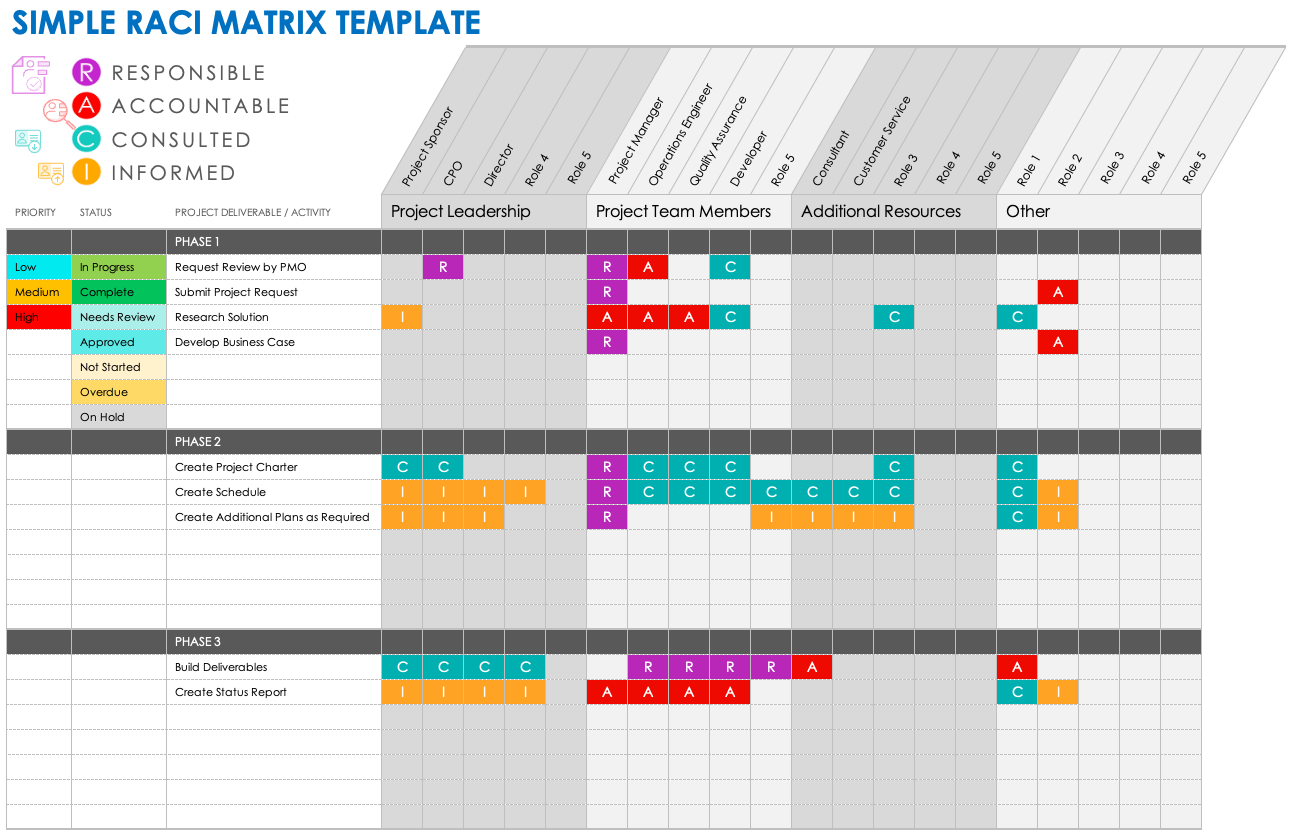
Download Simple RACI Matrix Template Microsoft Excel | Microsoft PowerPoint | Google Slides | Google Sheets
Use this simple RACI matrix template to assign project roles and easily track the progress of tasks. Enter your project’s title and the project manager’s name, and add due dates and current statuses for each task. There’s room to list which team members are responsible, accountable, consulted, and informed for tasks, making it clear to all project stakeholders who’s involved in each facet of the project. The template is fully customizable and designed to ensure that your team successfully completes all of your project’s deliverables.
Find more about RACI template resources in this comprehensive collection of free Microsoft Excel RACI templates .
RACI Model Template
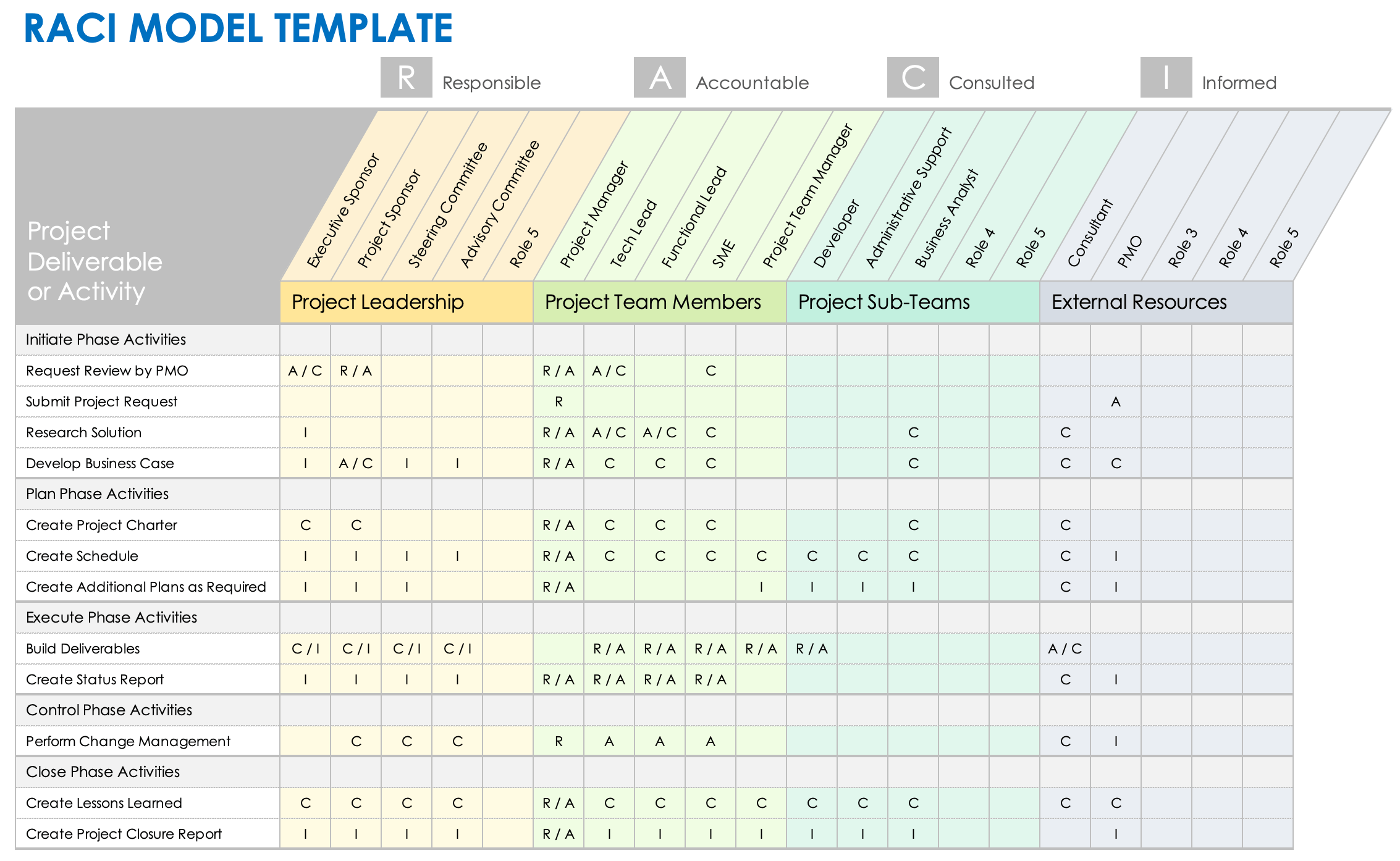
Download RACI Model Template Microsoft Excel | Microsoft Word | Microsoft PowerPoint | Google Sheets
Project managers, team members, and project sponsors can all use this RACI model template to ensure that roles and responsibilities are clear from the get-go. Easily add tasks to project phases (e.g., Initiate Phase Activities and Execute Phase Activities ) to see your project’s progress chronologically. Enter each task’s due date, percentage of progress toward completion, and status, as well as who is responsible, accountable, consulted, and informed for each task.
Find additional resources for presenting your RACI model and matrices to team members, project sponsors, and other stakeholders in this collection of Microsoft PowerPoint RACI templates.
Sample RACI Chart Template
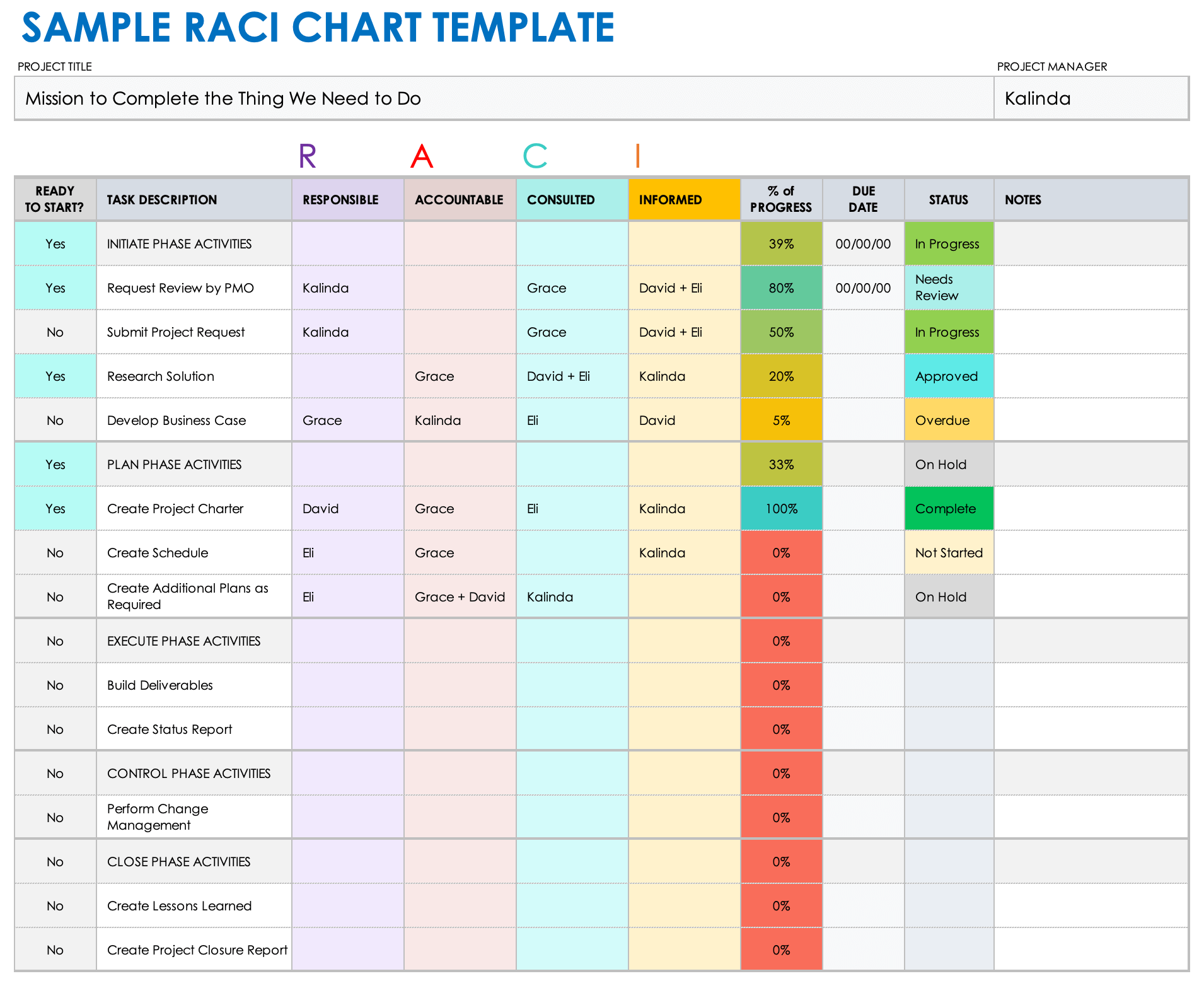
Download RACI Chart Template with Example Data Microsoft Excel | Microsoft Word | Google Sheets
This RACI chart template includes editable sample text to guide you through project planning and execution using the RACI matrix. Use the template to easily coordinate roles and responsibilities for each task required for project completion. With the built-in phases, you can assign individual project tasks to team members on a phase-by-phase basis as your project progresses.
See this collection of free RACI templates for Microsoft Word for more resources.
RACI Roles and Responsibilities Template
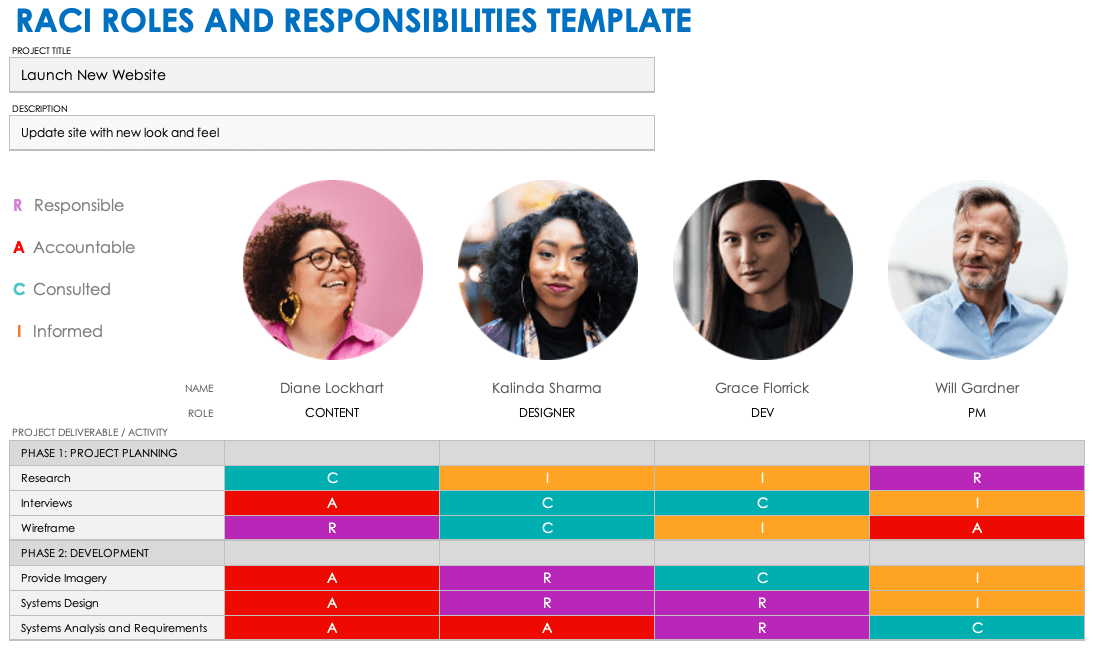
Download RACI Roles and Responsibilities Template Microsoft Excel | Microsoft Word | Google Sheets
Assign and track your project deliverables with this easy-to-use RACI roles and responsibilities template. Team members and project managers alike will benefit from the visually dynamic layout of this single-source, shareable roles and responsibilities for each task in your project.
Learn more about RACI template resources available for Google Sheets .
RACI for Change Management Template
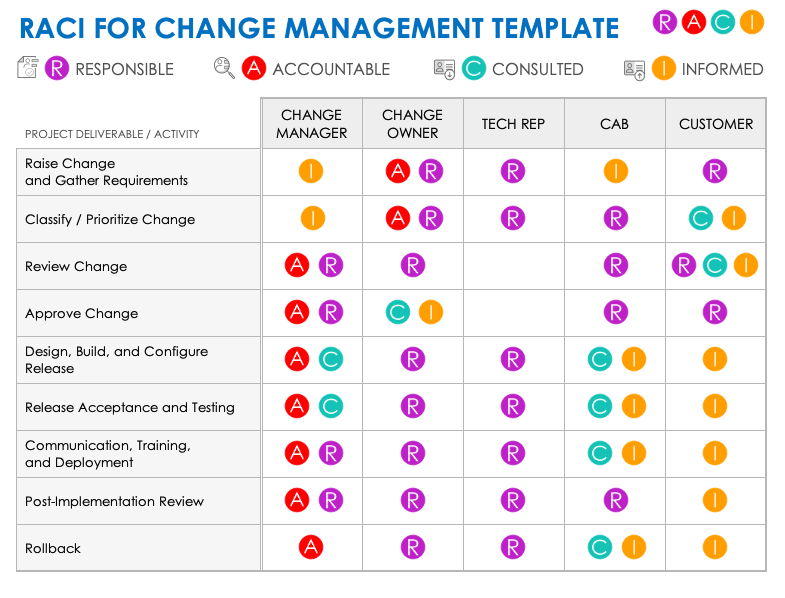
Download RACI for Change Management Template Microsoft Excel | Google Sheets
Designed specifically for change management practices , this template enables you to track organizational changes, as well as assign RACI roles and responsibilities. Scrum masters or project managers who need to organize their team’s change management-specific tasks will appreciate the include template headers: Change Manager, CAB (change-advisory board), Technical Representative, Change Owner, and Customer , so they can easily assign RACI roles and responsibilities for each task in the Activities column.
- RACI Matrix Table - Microsoft PowerPoint — Microsoft PowerPoint
RACI Responsibility Assignment Template — Microsoft PowerPoint
- RACI Software Matrix Template — Microsoft Word
- RACI Team Roles and Responsibilities Infographic — Microsoft PowerPoint
RACI Software Matrix Template
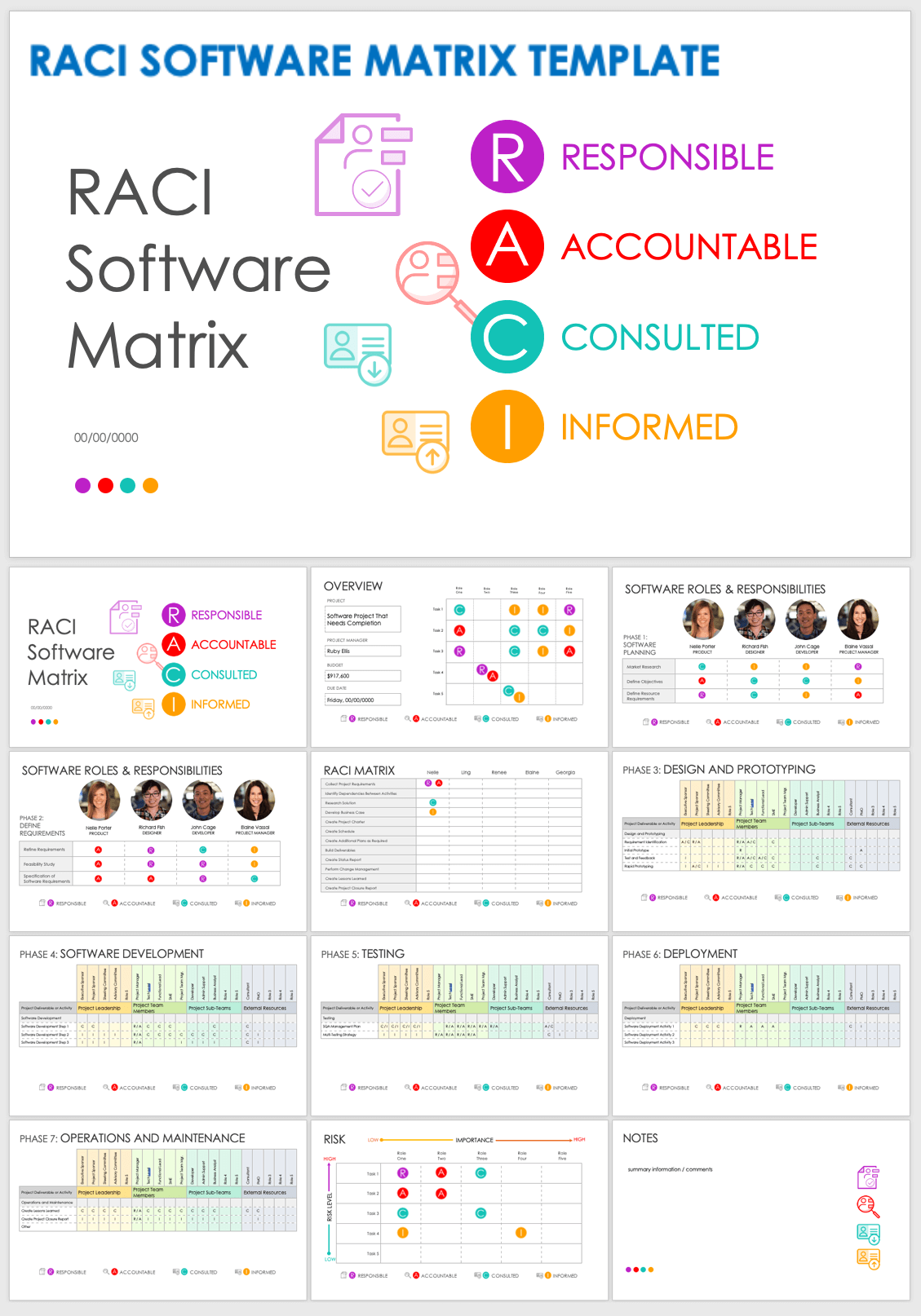
Download RACI Software Matrix Template — Microsoft Word
Software teams need a reliable way to assign project-task roles and responsibilities. They can use this template to assign and monitor tasks to account for every deliverable in major and minor software releases.
RACI Matrix Table
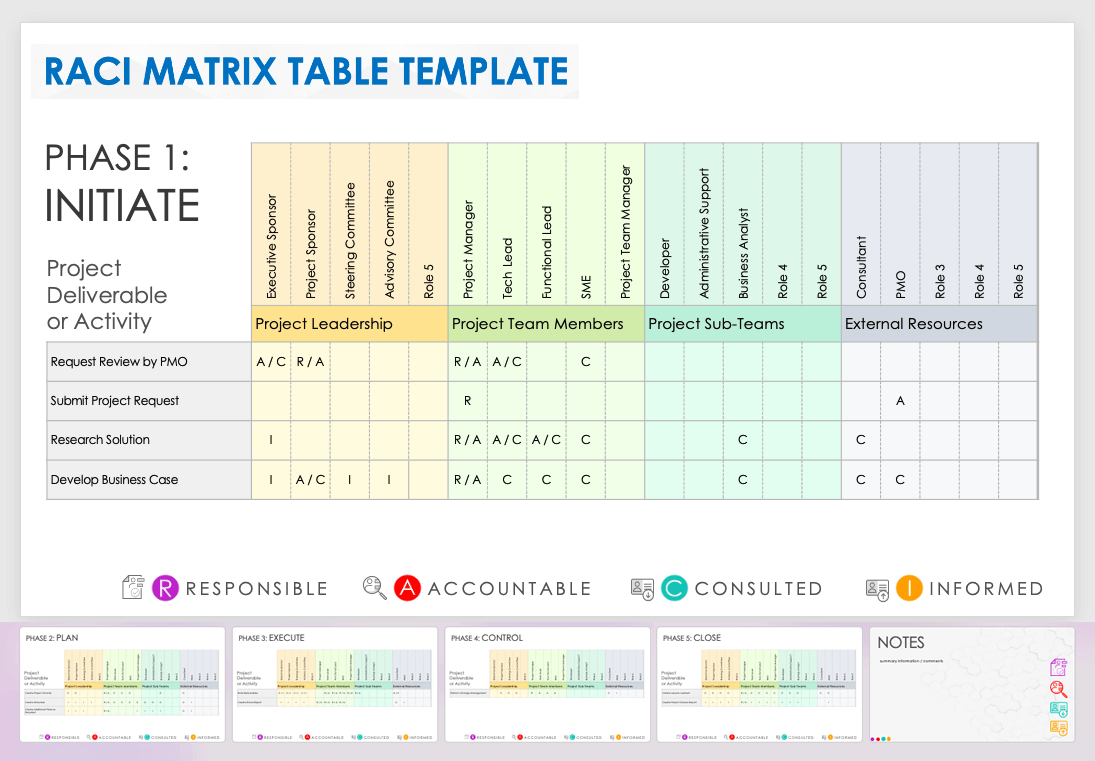
Download RACI Matrix Table — Microsoft PowerPoint
This presentation-ready RACI matrix table provides an easily readable, high-level snapshot of team members’ assignments and their respective roles. Upload team-member photos to help familiarize your project’s stakeholders with who’s involved on which tasks.
RACI Team Roles and Responsibilities Infographic
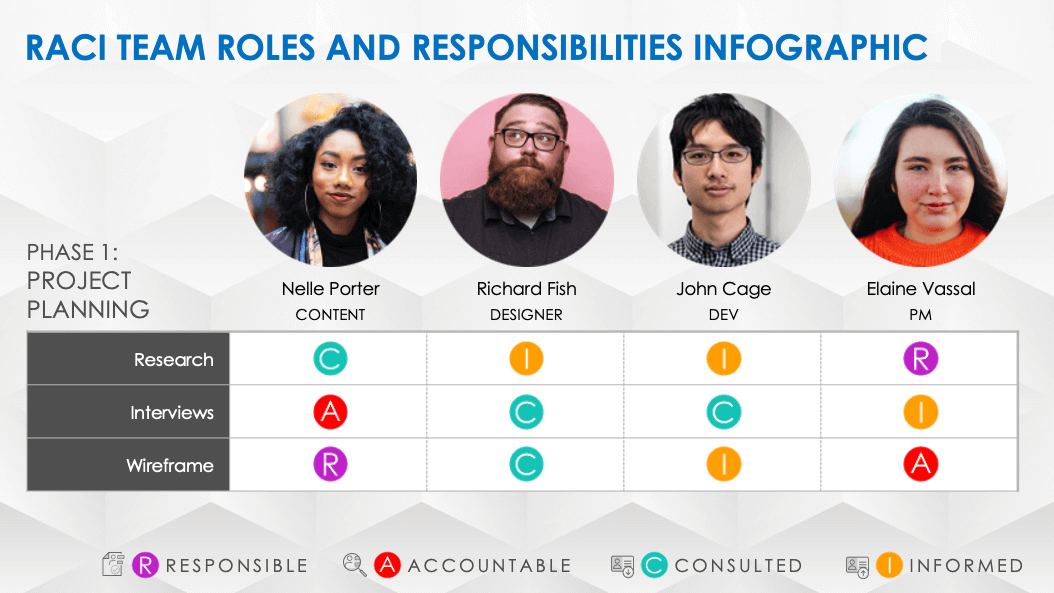
Download RACI Team Roles and Responsibilities Infographic — Microsoft PowerPoint
Use this presentation-friendly template for a visually rich overview of your project’s roles and responsibilities. This template is the perfect fit for project managers who want to effectively convey RACI assignments with team members, project sponsors, or other stakeholders.
RACI Responsibility Assignment Template
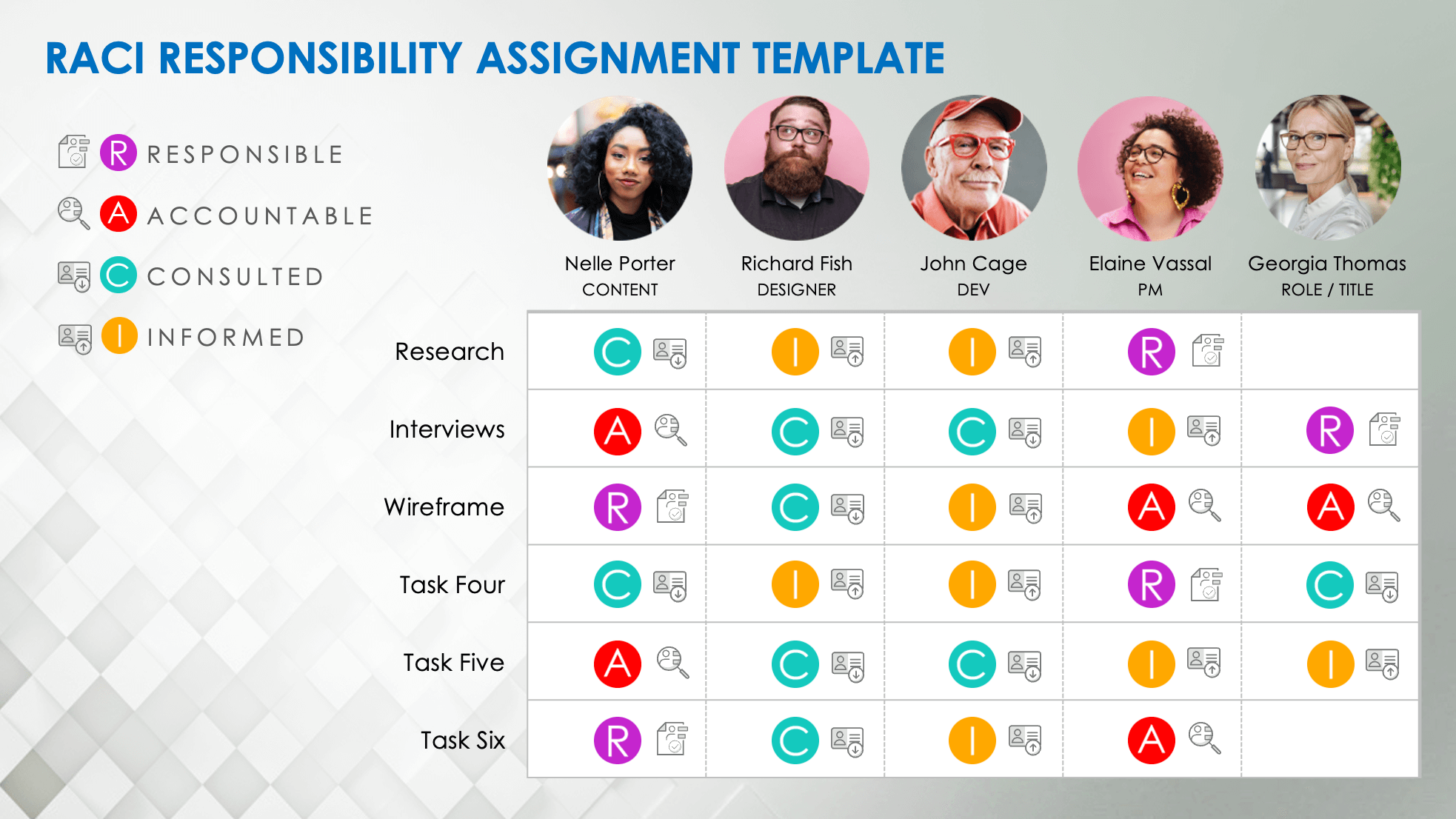
Account for all project roles and responsibilities with this dynamic RACI responsibility assignment template. Complete and present to stakeholders, so they’ll know which team members are responsible, accountable, consulted, and informed for each project task.
ITIL RACI Matrix Template
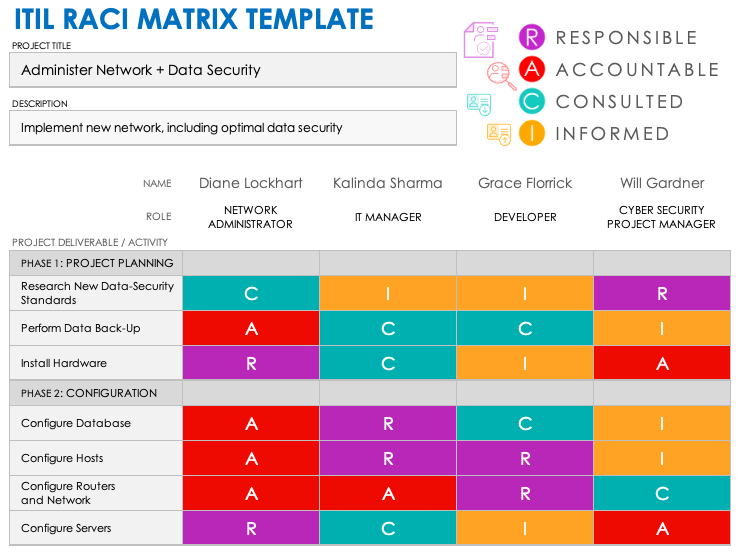
Download ITIL RACI Matrix Template Microsoft Excel | Google Sheets
This ITIL RACI matrix template is the perfect tool to assign RACI roles for all of your IT operations because it helps you adhere to the Information Technology Infrastructure Library (ITIL) set of detailed practices. Completely customizable, this template provides a comprehensive method for assigning roles and responsibilities to each IT help desk request.
Find more ITIL resources in this comprehensive collection of ITIL RACI templates .
ITIL RACI Template with Gantt Chart
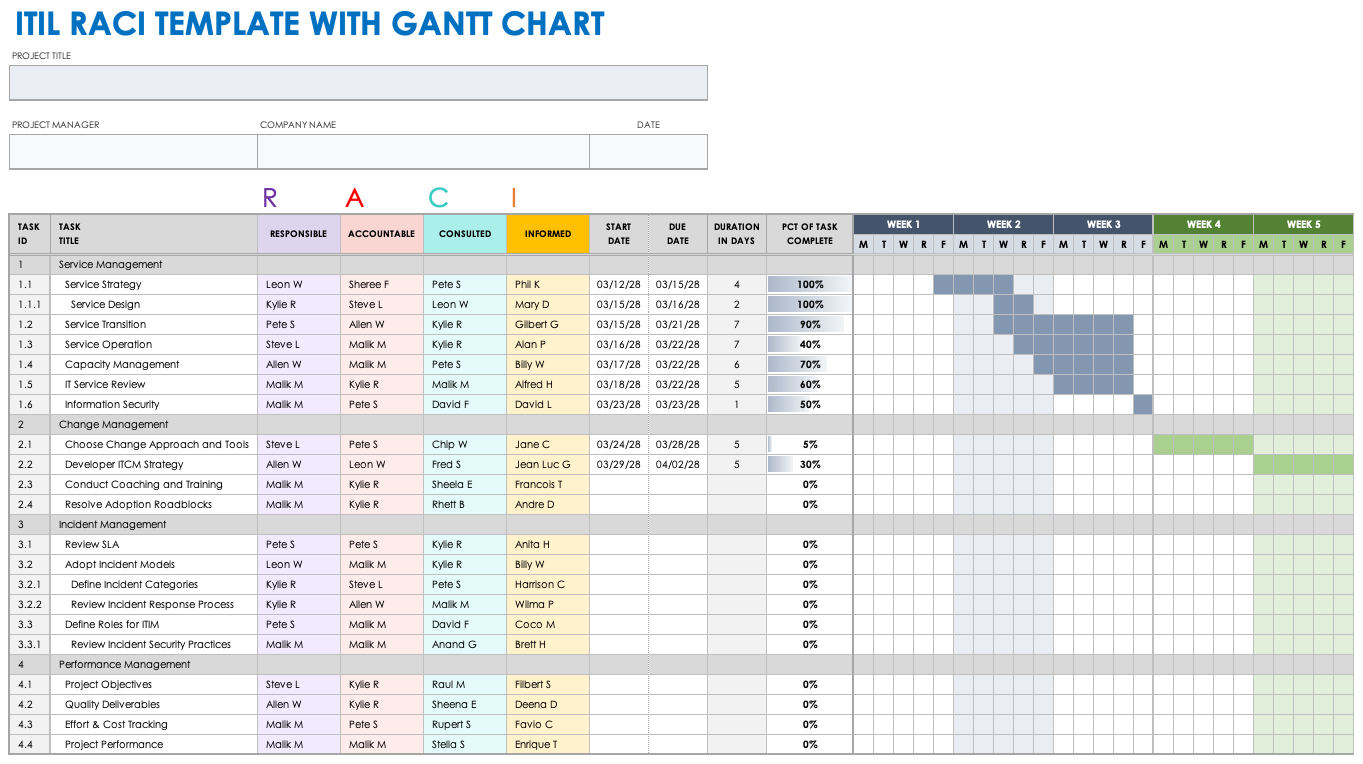
Download ITIL RACI Template with Gantt Chart Microsoft Excel | Google Sheets
Pairing RACI structure with a Gantt chart provides project managers, sponsors, and team members with easy-to-follow information on roles and responsibilities for all of your ITIL activities . This template is a helpful tool for those working in IT change management (ITCM), IT incident management, and IT service management (ITSM). Use this ITIL RACI template with Gantt chart to proactively track and manage all of your IT services.
RACI for ITIL Change Management Template
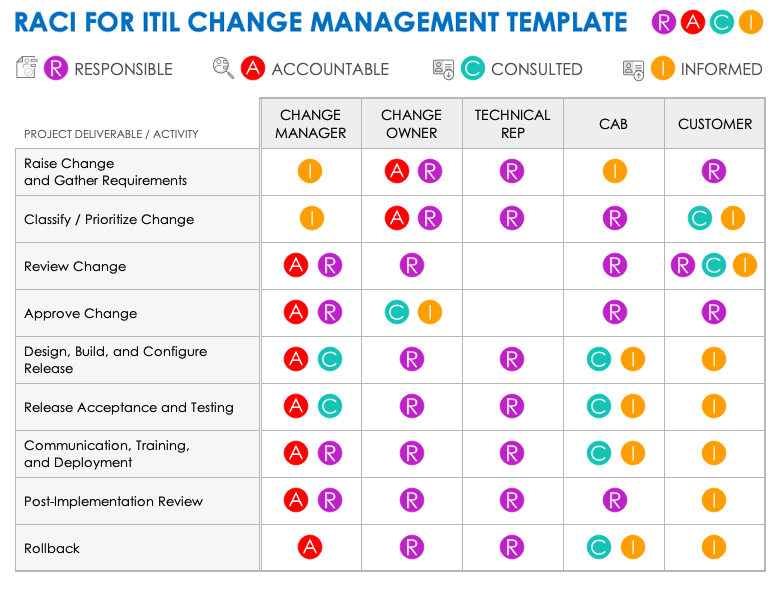
Download RACI for ITIL Change Management Template Microsoft Excel | Google Sheets
Project managers will appreciate this comprehensive RACI for ITIL change management template. They can use it to capture any scheduled changes and to assign the IT team members who are responsible, accountable, consulted, and informed (RACI) to the changes’ individual tasks. For each IT change management (ITCM) task, you can assign change management-specific RACI roles, such as a change owner, a change manager, a technical representative, change advisory board (CAB) members, and customers.
ITIL Incident Management RACI Matrix
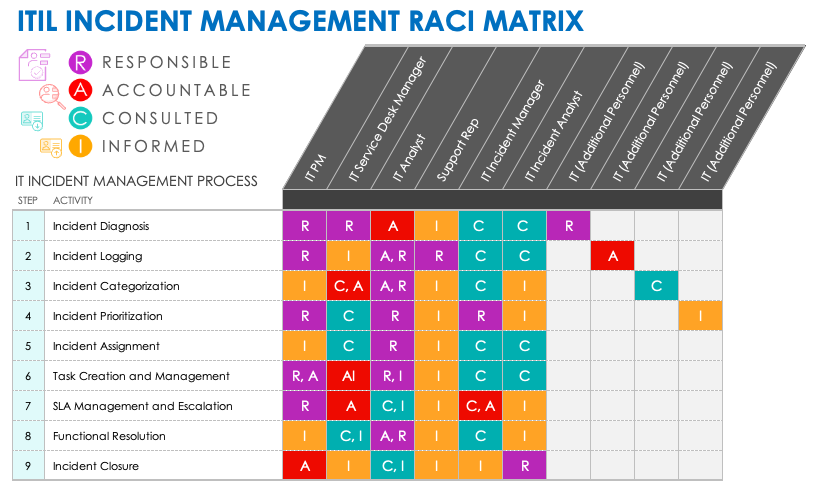
Download ITIL Incident Management RACI Matrix Microsoft Excel | Google Sheets
Use this template to create and customize each IT task (e.g., setting up new-hire hardware and software). Assign tasks to team members responsible for completing them, as well as who is accountable for the work being completed, who has been consulted, and who has been informed that IT has undertaken the work.
ITIL Service Management RACI Template
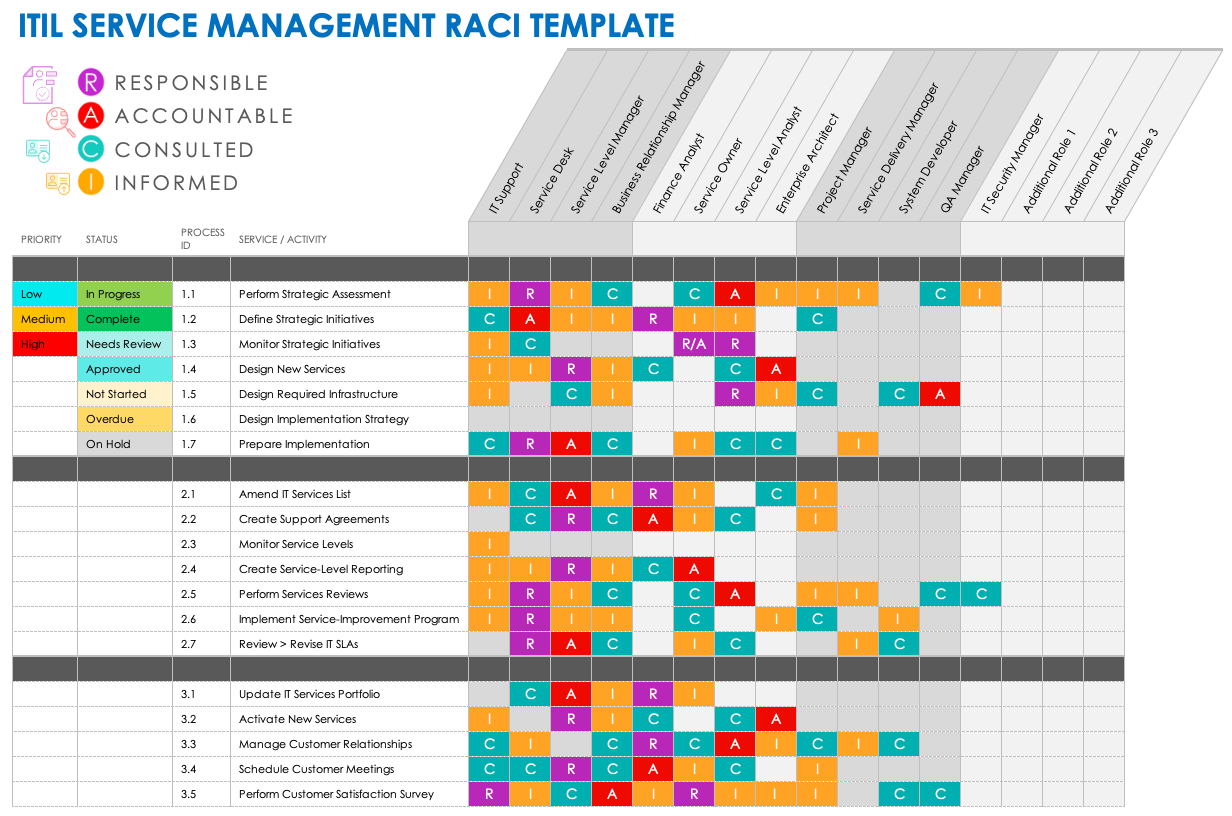
Download ITIL Service Management RACI Template Microsoft Excel | Google Sheets
IT managers and IT team members alike can use this ITIL service management RACI template to anticipate and record information technology service management (ITSM) helpdesk requests. Once you gather service-request details from clients and record them in the template, you can assign RACI roles for each request.
ITIL RACI Cross-Supplier Template
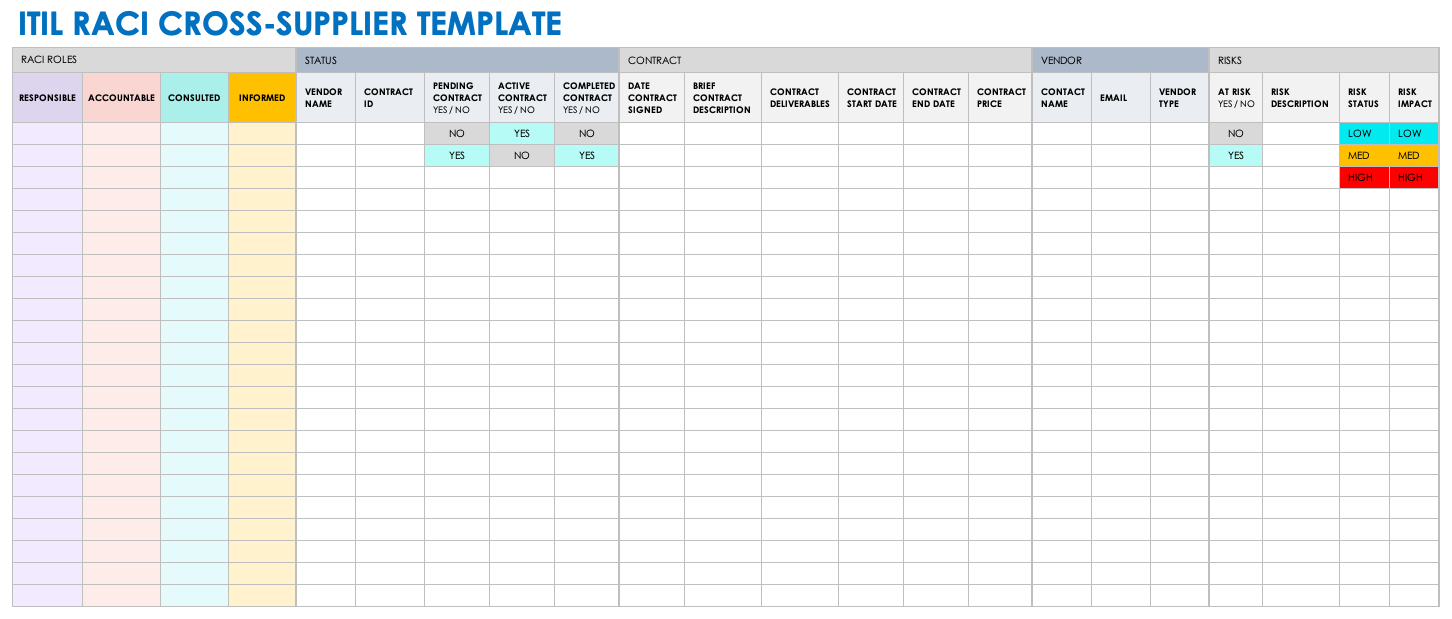
Download ITIL RACI Cross-Supplier Template Microsoft Excel | Google Sheets
This ITIL RACI cross-supplier template assists IT project management to accurately record and manage supplier contract details. Use it to assign IT personnel their various RACI roles, so that it is clear to everybody on your IT team who is fulfilling which component of your suppliers’ contract details.

Agile RACI Roles and Responsibilities Matrix Template
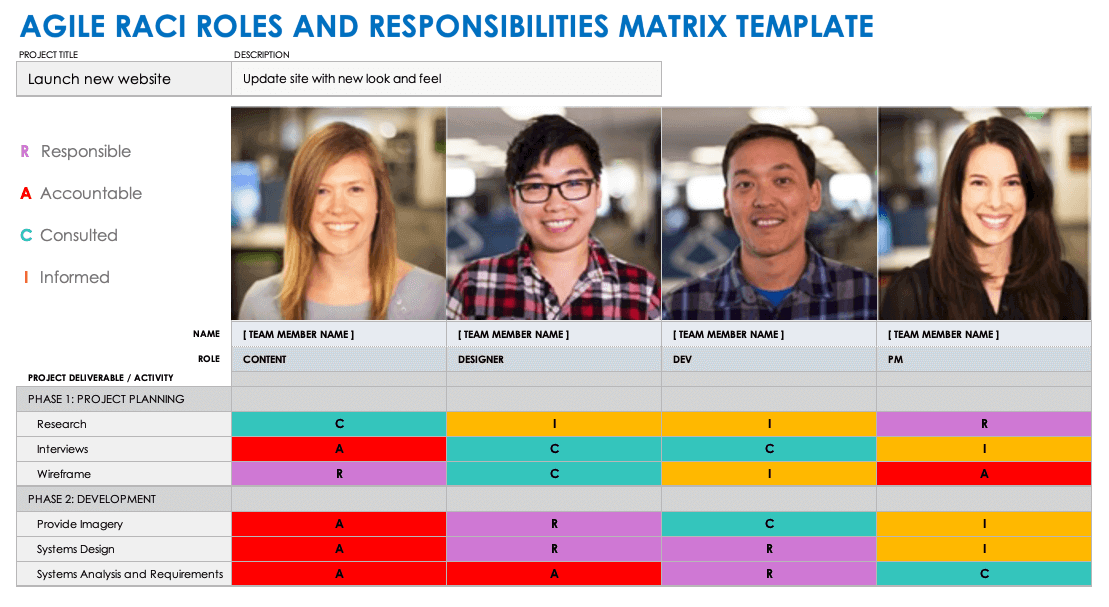
Download Agile RACI Roles and Responsibilities Matrix Template with Example Data Microsoft Excel | Google Sheets
Download Blank Agile RACI Roles and Responsibilities Matrix Template Microsoft Excel | Google Sheets
This straightforward Agile RACI roles and responsibilities matrix template offers an easy way for Agile teams to assign RACI roles for a sprint’s features, deliverables, and individual tasks. Enter each sprint-specific task detail, and who is responsible, accountable, consulted, and informed. This way, it’s clear what must be completed by the end of your sprint, as well as who is assigned to which tasks and their roles.
Find more resources in this comprehensive collection of Agile RACI templates .
Agile Planning RACI Presentation Template
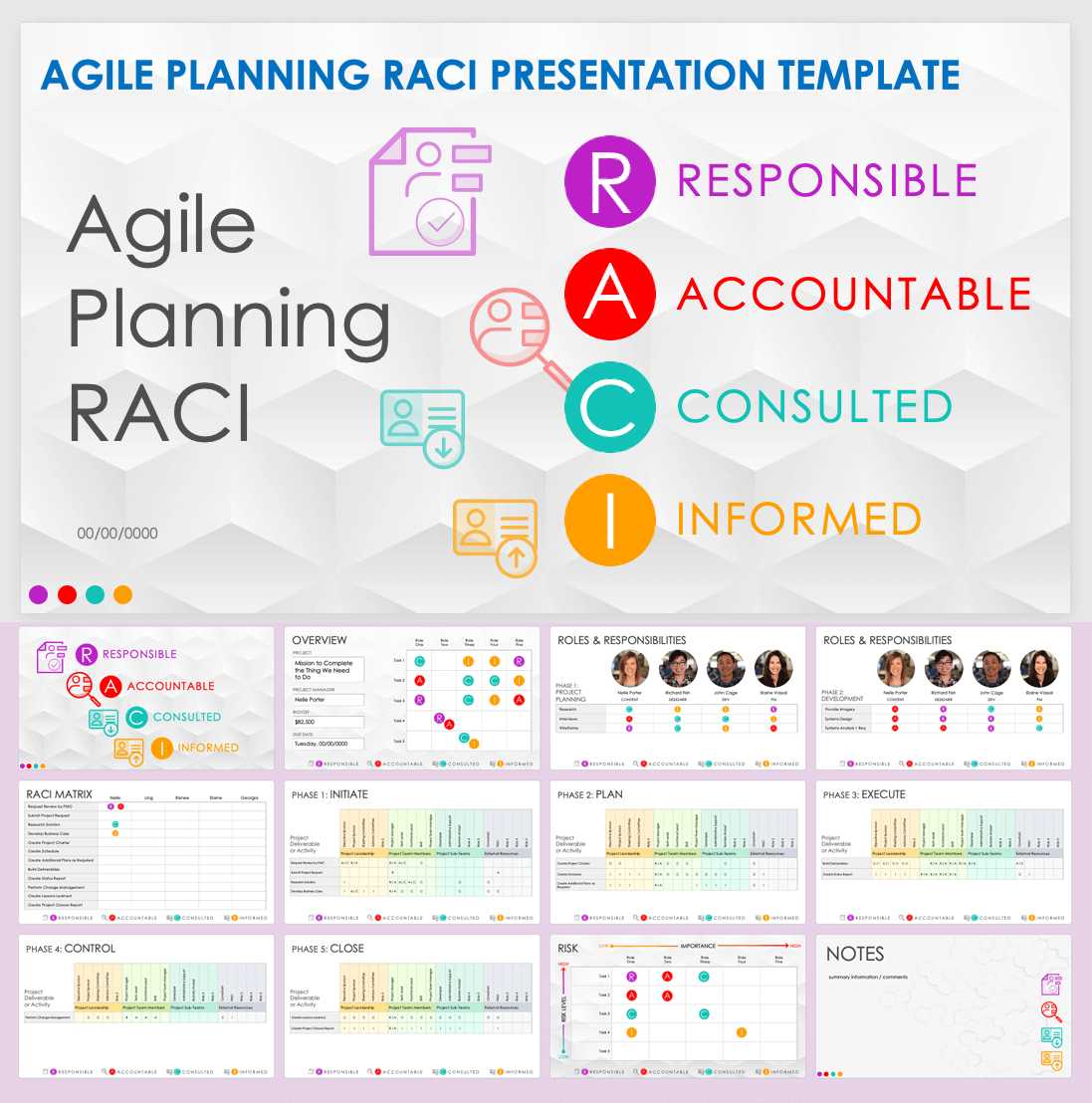
Download Agile Planning RACI Presentation Template Microsoft PowerPoint | Google Slides
Proactively plan and assign accurate Agile sprint and release roles and responsibilities details with this Agile planning RACI presentation template. This visually rich template features ready-to-use slides that help Agile Scrum masters, project managers, and product managers present project-assignment details, so that the division of responsibilities is clear to all stakeholders.
Agile RACI Matrix by Assignment Template
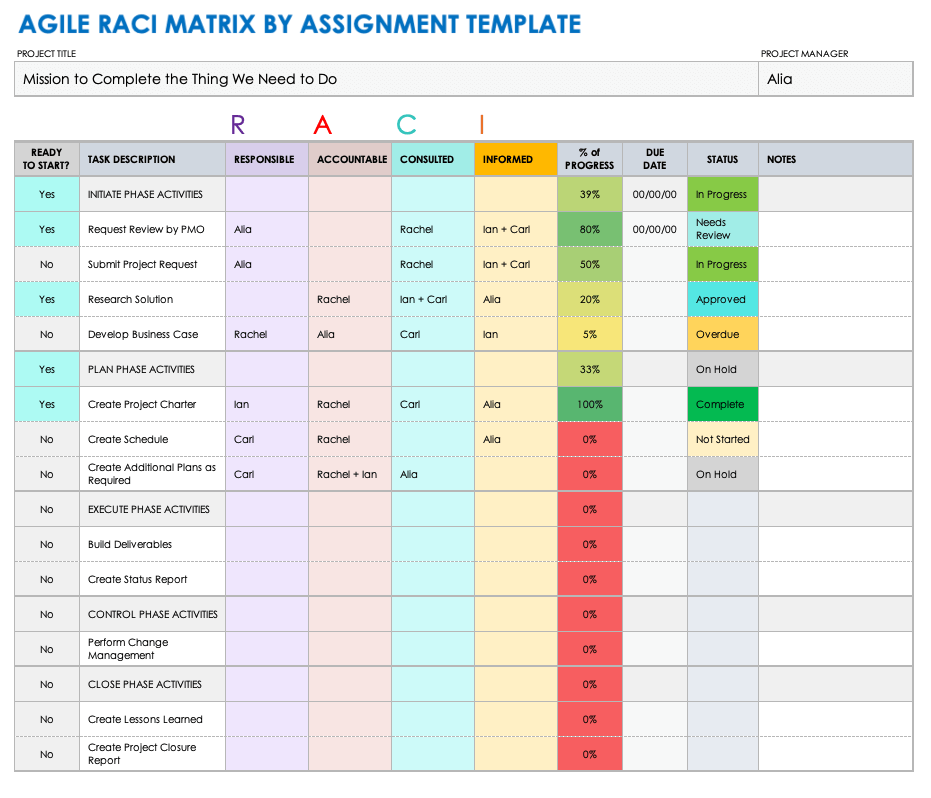
Download Agile RACI Matrix by Assignment Template Microsoft Excel | Google Sheets
Use this Agile RACI matrix by assignment template to clarify your team’s roles and responsibilities, and to standardize your Agile RACI practices. By adopting this RACI matrix model and methodology for your Agile sprints, everyone will be clear what their role is in fulfilling each sprint’s tasks.
What Is a RACI Template?
A RACI template is a roles-and-responsibilities matrix that clarifies the team member involved in each individual task. Use a RACI template to provide project-task role clarification for project board members, team members, and other stakeholders.
A RACI template provides not only who is responsible (the person performing the project task), but also who is accountable for ensuring it’s completed, who has been consulted regarding the task, and who has been informed that someone is working on the task.
Reference this RACI definition list when deciding which letters to assign to team members for each project task:
- Responsible: Assign an R to the team member responsible for completing the task.
- Accountable: Assign an A to the individual accountable for ensuring the task is completed by the assignee.
- Consulted: Assign a C to the individual who has been consulted on the task.
- Informed: Assign an I to the person who has been informed that the task is underway.
Using a RACI roles and responsibilities template provides a straightforward view of who is responsible for completing tasks, along with who else is involved in the task and their respective roles.
While individual RACI templates may vary, most typically include the following components:
- Due Date: Set a due date to complete each project task, feature, or deliverable.
- Notes: Add any relevant notes related to RACI matrix roles and responsibilities for each project task, feature, or deliverable.
- Percentage Complete: Provide a percentage of completion for each task.
- Phase: Add the name of the project phase under which you will assign tasks on the matrix.
- Project Title: Write the name of your project to which you will apply RACI matrix attributes.
- Project Manager: Enter the name of the project manager responsible for ensuring task and project completion.
- RACI: Designate which team members or interdepartmental stakeholders are responsible, accountable, consulted, and informed for each task, per the RACI matrix.
- Status: Include the status for each project task so that team members and other stakeholders are aware of its progress and how close it is to completion.
- Task Description: Provide a brief summary for each task that must be successfully completed for the project.
Read this guide to RACI project management to learn more about how to use this process.
Easily Assign, Manage, and Track RACI Assignments with Smartsheet
Empower your people to go above and beyond with a flexible platform designed to match the needs of your team — and adapt as those needs change.
The Smartsheet platform makes it easy to plan, capture, manage, and report on work from anywhere, helping your team be more effective and get more done. Report on key metrics and get real-time visibility into work as it happens with roll-up reports, dashboards, and automated workflows built to keep your team connected and informed.
When teams have clarity into the work getting done, there’s no telling how much more they can accomplish in the same amount of time. Try Smartsheet for free, today.
Discover why over 90% of Fortune 100 companies trust Smartsheet to get work done.
Skip to main content
- Contact sales
- Get started Get started for free
Figma Design
Design and prototype in one place

Collaborate with a digital whiteboard

Translate designs into code

Figma Slides
Co-create presentations

Explore all Figma AI features
Get the desktop, mobile, and font installer apps
See the latest features and releases
- Design systems
- Prototyping
- Wireframing
- Online whiteboard
- Team meetings
- Strategic planning
- Brainstorming
- Diagramming
- Product development
- Web development
- Design handoff
- Engineering
- Product managers
Organizations
Creator fund
Build and sell what you love
User groups
Join a local Friends of Figma group
Learn best practices at virtual events
Customer stories
Read about leading product teams
Shortcut: The Figma blog
Stories about how products take shape—and shape our world

Get started
- Developer docs
- Best practices
- Reports & insights
- Resource library
- Help center
What is a RACI matrix? (with examples)

Say your team is asked to design a new product feature. Exciting news—but you'll need more information before you get cracking. Who's approving the project, building it, and managing the timeline? The quickest way to collect and communicate that information is a RACI matrix, a diagram that shows who's doing what on your project.
With this guide, you'll discover:
- What a RACI matrix is, and how it assists with project management
- How to improve your project plan with a responsibility matrix
- How to build your own RACI diagram with FigJam's RACI chart template
What is a RACI matrix?
A RACI matrix—often called a RACI chart or responsibility assignment matrix (RAM)—is a project management tool that captures the roles and responsibilities of project stakeholders. Team members can see who does what at a glance, clarifying different roles across complex projects. The acronym RACI stands for:
- Responsible refers to the individual or group performing a particular task. For example, the UX team might be tapped as the responsible party for mapping out specific product design features. Make sure each task has at least one responsible person.
- Accountable refers to the person who ensures a task is completed successfully. To avoid confusion, make sure teach task has only one accountable role. This is usually filled by a manager or a high-level team member with the authority to delegate project tasks.
- Consulted describes individuals whose feedback factors into project workflows, but aren't involved in day-to-day tasks. This includes subject matter experts or decision makers who are consulted for input or sign-off on project milestones. For example, a business analyst may be consulted about competitive research to inform design decisions.
- Informed describes anyone who needs updates on task progress across project phases, but isn't necessarily involved in task execution. For example, developers building design features may need real-time updates on design task completion or setbacks to plan their work.
In this matrix example , the UI designer is responsible for creating the design and the product owner is accountable for making sure that design gets done. The content writer may be consulted, and the CEO is informed about project milestones.
4 key benefits of a RACI matrix
The RACI matrix is commonly used in agile and scrum methodologies because it helps keep complex projects moving toward successful completion in four key ways:
1. Role clarity
By clearly defining Responsible, Accountable, Consulted, and Informed roles, a RACI matrix minimizes confusion, ambiguity, and overlap. This ensures that everyone involved in the project is on the same page and understands what is expected of them.
2. Communication
A RACI matrix outlines who should be consulted and informed at every stage of the project. This invites open and consistent communication—the lifeblood of any team project.
3. Efficiency
Outlining distinct roles and responsibilities with a RACI chart helps streamline team efforts and clarify project tasks, helping your project run smoother and faster.
4. Accountability
When you put your RACI matrix on your project dashboard, everyone can see who's responsible for which tasks and project deliverables. This establishes shared accountability, fostering teamwork and ownership among team members.
How to build a RACI matrix in 5 steps
You can create a RACI matrix for effective project management in five steps using this RACI matrix template in FIgJam.
- Outline all tasks. Start by listing all the tasks or deliverables for the project. In the first column of your table, prioritize and arrange tasks in the order they must be accomplished.
- Identify project team members. Name all team members or stakeholders involved in the project. List them across the top row.
- Assign project roles. For each specific task, assign RACI roles (Responsible, Accountable, Consulted, and Informed) to the appropriate team member. Make sure to assign one accountable person per task, to keep project progress on track.
- Review and revise. Double check that each project task is identified and every team member's role is represented. Leaving out tasks or roles can create confusion and leave project gaps. Plan regular reviews to update the matrix with ongoing changes, like completed tasks, role shifts, or new tasks.
- Communicate and implement. Whenever possible, involve the whole team in the creation of the RACI matrix. To build buy-in and understanding. Once project team members and stakeholders sign off on the matrix, incorporate the tasks into your project management process.
3 alternative approaches to RACI charts
While the RACI model is widely used, this exhaustive list provides alternatives. These three may be more suitable depending on a project's or organization's needs:
- RAPID : This methodology created by Bain & Company coordinates decision-making in five steps: Recommend, Agree, Perform, Input, Decide.
- DACI : This framework aids group decision-making by assigning specific roles: Driver, Approver, Contributor and Informed.
- RASCI : This variation of the RACI model acronym includes an additional "S" for Supportive team members.
Jumpstart your RACI matrix with FigJam
To make your own RACI matrix, try the free FigJam RACI matrix template . Then finesse your matrix with these pro tips:
- To get your team involved with your RACI, use FigJam's collaborative features like stamps, stickers, emotes, and high-fives .
- Transform tasks and deliverables into actionable to-dos with FigJam's task management widgets, project management integrations, and Gantt chart maker .
- Customize your matrix with brand elements from your company's Figma brand library.
- For more inspiration, browse the library of RACI matrix templates shared by the Figma design community.
Ready to assign project roles and responsibilities?
Keep reading
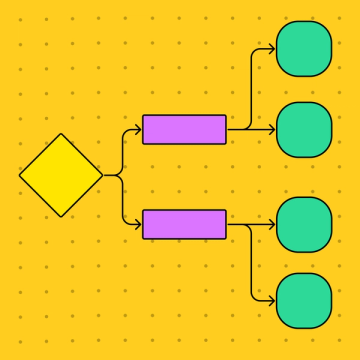
How to create a flow chart
Having a flow chart can help visually represent actions or people in a complex situation.
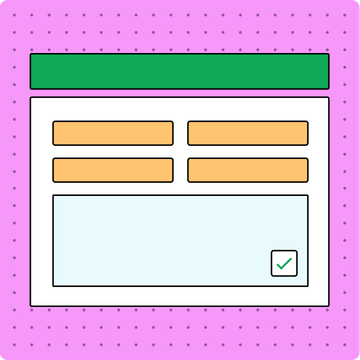
How to create a project status report
Whether you’re developing a new product or launching a marketing campaign, your company’s success hinges on keeping your project on track
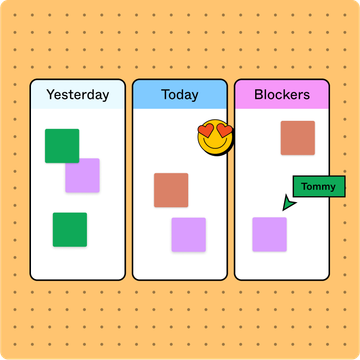
How to run great daily standups
How do you make sure everyone's on board, on task, and on track for a productive day ahead?
- Product overview
- All features
- Latest feature release
- App integrations
- project icon Project management
- goal icon Goals and reporting
- asana-intelligence icon Asana AI
- workflow icon Workflows and automation
- portfolio icon Resource management
- my-task icon Admin and security
- list icon Personal
- premium icon Starter
- briefcase icon Advanced
- Goal management
- Organizational planning
- Project intake
- Resource planning
- Product launches
- View all use cases arrow-right icon

- Help Center
- Asana Academy
- Certifications
- Work management hub
- Customer stories
- Get support
- Developer support
- Customer Success
- Project plans
- Team goals & objectives
- Team continuity
- Meeting agenda
- View all templates arrow-right icon
- Project management |
Your guide to RACI charts, with examples

Can you identify exactly who’s doing what by when for each task, milestone, and deliverable in your project? If not, you might need a RACI chart.
RACI is an acronym to help teams clarify project roles and figure out who the responsible party is for any given task. Whether you've never heard of RACI before or you’re considering creating a RACI chart for your next project, here’s everything you need to know about how to create and use these charts.
3 ways to transform your enterprise project management
Watch a live demo and Q&A session to help you streamline goal-setting, accelerate annual planning, and automate how teams intake strategic work.
What is a RACI chart?
Responsible.
This person is directly in charge of the work. There should only ever be one Responsible role per task so you know who to go to with questions or updates. If a task has more than one Responsible person, you can lose clarity and cause confusion. Instead, aim to add additional collaborators as some of the other RACI roles, which can have more than one person.
Accountable
The Accountable person is responsible for overseeing overall task completion, though they may not be the person actually doing the work.
There are two ways to assign an Accountable role. Sometimes, the Accountable is the project manager (or even the Responsible, though in that case the person is taking on two different roles during the task workflow). In these cases, the Accountable is responsible for making sure all of the work gets done.
In other cases, the Accountable is a senior leader or executive who is responsible for approving the work before it’s considered complete. Like the Responsible role, there should only ever be one Accountable.
This will be the person or people who should review and sign off on the work before it’s delivered. There may be multiple Consulted roles for each task, project milestone , or deliverable.
This is the person or group of people who are informed about the progress and completion of work. They probably are not involved in any other aspect of the deliverable.
When should I create RACI charts?
RACI charts are a helpful way to track each stakeholder’s role for a task, milestone, or deliverable—especially if you’re managing a complex project with many decision makers and subject matter experts. With a RACI chart, you can prevent poor decision making and avoid roadblocks in the approvals process that could impact overall project success.
These charts, while different from PERT charts , are especially useful if your stakeholders may be taking on different roles throughout the project. For example, there could be a stakeholder who is Responsible on one deliverable but Informed on another. With a RACI chart, you can clearly outline these details and make sure everyone knows who’s responsible for what.
How to make a RACI chart
Ever felt like your project was spinning out of control, with team members unsure of their roles and responsibilities? You're not alone. This is when a RACI chart comes in handy. Let's walk through the steps of creating a RACI diagram with a software development project as an example.
Step 1: List the project tasks
Start by breaking down your project into specific activities or deliverables. For our software project, tasks might include:
Define project scope
Design wireframes
Develop front-end code
Conduct user testing
Launch the site
These tasks cover key phases in the project lifecycle and give team members a clear understanding of what needs to be accomplished from start to finish.
Step 2: Identify key stakeholders
Next, identify all the roles involved in your project, from team members to stakeholders. For our RACI chart example, we might have:
Project Manager : Oversees the entire project.
Business Analyst : Gathers requirements and ensures they’re met.
UX Designer : Responsible for creating wireframes and the user experience.
Front-End Developer : Codes the website.
Marketing Team : Needs to be informed of key milestones for launch coordination.
IT Support : Handles post-launch maintenance.
This step ensures that no team member is left in the dark and that all informed parties are represented.
Step 3: Assign RACI matrix roles
Now, for each specific task, decide who's responsible, accountable, consulted, and informed. With the example of "Defining project scope," you might have:
R: Business analyst
A: Project manager
C: UX designer
I: Front-end developer, marking team, and IT support.
Remember, there should only be one 'A' per task to avoid confusion!
Step 4: Review and adjust
Go through the RACI framework with your team. Look for gaps, overlaps, or ambiguities and iron them out. Maybe you realize the backend developer should be consulted on the UX design to confirm feasibility.
Step 5: Share the RACI chart
Finally, share the RACI chart template with the entire team and any other key stakeholders. In the case of the software development project, the RACI framework helps each project team member know their role in delivering the final product. Sharing this chart helps reduce miscommunication and makes sure the project progresses smoothly.
By following these steps, you'll create a powerful tool to streamline communication and clarify roles throughout your project phases. No more confusion about who's doing what—your team can focus on what they do best, moving your software from concept to launch with less miscommunication and more efficiency.
RACI chart example
To build a RACI chart, list every task, milestone, or deliverable for your project. Then, identify who the Responsible, Accountable, Consulted, and Informed team members are for each one.
Let’s say you’re updating the homepage on your website. Project stakeholders include:
Head of website
Web developer
You want to create a RACI diagram for five tasks and deliverables:
Update homepage CTAs
Update customer story on homepage
Revamp website design
Improve homepage loading speed
Update homepage design
The RACI chart would look like:
Responsible: Copywriter
Accountable: Web developer
Consulted: Head of website
Informed: Designer
Revamp video on homepage
Responsible: Designer
Informed: Copywriter
Responsible: Web developer
Informed: Copywriter & Designer
Pros and cons of RACI charts
Ultimately, the question is: should you create a RACI chart? While RACI charts are a useful tool to identify project responsibilities, they can get a little cumbersome over the lifecycle of a project. Here are the pros and cons of creating a RACI matrix for your team’s work:
RACI charts benefits
Clear project roles and responsibilities can help your team move fast and reduce confusion about who’s working on what. With a RACI chart, you can ensure you don’t have two team members working on the same thing. As a result, you’ll have an easier time collaborating with your team.
RACI charts are also particularly helpful when the decision-making process is split between tasks. There might be scenarios where the Informed on one task or milestone is the Responsible or Consulted on another—in order to have that clearly defined, it’s helpful to track this work in a RACI diagram.
RACI chart pitfalls (and how to avoid them)
RACI models focus on the granular, instead of capturing work at the project level. You might know who the Consulted is on a particular task—which is helpful—but knowing that doesn’t help you understand how various stakeholders interact with the broader project work.
Additionally, if you attempt to write out each task and each role, your RACI chart can get bulky. Worse, if your project changes in some way, your RACI diagram would immediately become outdated. That can make it hard for you to gain real-time clarity about where each task is in your project workflow.
RACI charts are limited because they aren’t able to adapt to your project needs in real time. In order to establish clear expectations and eliminate confusion on the project level, you need a project management tool .
RACI matrix alternatives
While the RACI matrix is widely used, it's not the only game in town. In fact, frameworks like DACI, RASCI, RAS, CARS, and CLAM can be tailored to fit specific project plans and methodologies.
Here are some popular RACI alternatives that might better suit your project needs.
The DACI model is a variation of RACI, with a stronger focus on decision-making. It breaks down as follows:
Driver: The person responsible for carrying the project forward.
Approver: The decision-maker who has the final say.
Contributor: Team members providing input and expertise.
Informed: Individuals who need to be kept up to speed on project progress.
This model is particularly useful in agile environments where decisions need to be made quickly and with input from many different team members. It emphasizes the importance of having a clear approver to avoid delays.
RASCI adds an extra layer to the traditional RACI model. The 'S' stands for support. In this RACI framework:
Responsible: The person performing the task.
Accountable: The person accountable for the task.
Supportive: Team members providing additional help or resources.
Consulted: People whose input is required.
Informed: Those who need to be informed of progress.
The RASCI model is useful in projects with more complex roles, especially when there’s a need to clearly define supportive roles to avoid overlaps in responsibilities.
RAS is a simplified version of a RACI chart that focuses on just three key roles:
Responsible: The person doing the work.
Accountable: The person overseeing the task.
Supportive: People providing resources or assistance.
RAS works well in smaller teams or in scrum methodologies where the focus is on speed and efficiency.
CARS flips the script a bit by focusing on who's in charge of communication, which is especially helpful in project plans that require multiple layers of approval and clear communication channels. It looks like this:
Communicate: Who needs to be kept in the loop.
Approve: Who has final decision authority.
Responsible: Who will complete the work.
Support: Who provides help or resources.
CARS is often used in industries that require heavy compliance or formal approval processes, where miscommunication can cause serious delays.
For a different approach, there's CLAM. This model can be particularly useful in Agile or Scrum environments, where leadership and oversight need to be clearly defined. Here's what it looks like:
Contribute: Team members providing direct input or work.
Lead: The individual overseeing the task.
Approve: The one with decision-making power.
Monitor: Those keeping an eye on project progress and ensuring everything stays on track.
CLAM is beneficial in projects with complex methodologies, where tasks require significant collaboration but also demand clear leadership and approval processes.
Take your RACI chart to the next level
With project management software, every task has an assignee—that’s the Responsible. You can see work on the project level, so the Accountable and Informed don’t have to check in via email or status meetings. And, for any approvals you need from your Consulted, you can track reviews and approvals in one place. That way, your entire RACI team has a central source of truth for all of the work being done.
![sample responsibility assignment matrix [Product UI] Brand campaign RACI chart (Lists)](https://assets.asana.biz/transform/f8cc1f69-97b6-4806-9471-b27453e459a9/inline-generic-list-2x?io=transform:fill,width:2560&format=webp)
Instead of having your RACI chart separate from where the work is happening, project management tools capture the topic, assignee, and other important information like the task due date or relative importance. That way, your entire project team has visibility into who’s doing what by when—and you’re not relying on a single person to manage and update your RACI chart. Project management tools update in real time, so you can see exactly where you are in the approval process.
Track who’s doing what by when
Clear team roles and responsibilities help you hit your deliverables on time. Tracking different and complex stakeholder responsibilities in a RACI matrix can help you do that—but RACI charts are just the beginning. Learn more about work management , and how your team can benefit.
Related resources

How to use benchmarking to set your standards for success

How to scale retail management operations with Asana

How Asana’s digital team used work management to refresh our brand

Everything you need to know about requirements management
Popular Insights:
Best Project Management Software
Mind Mapping Software
What Is a RACI Matrix? Definition, Examples, Uses
Reviewed by
Share this Article:
Our content and product recommendations are editorially independent. We may make money when you click links to our partners. Learn more in our Editorial & Advertising Policy .
Key takeaways
Featured Partners
{{ POSITION }}. {{ TITLE }}
Successful project management depends on a team-wide understanding of roles and responsibilities. Using a RACI matrix to assign and define each role is a great way to keep a project on track and positioned for success, especially when used in conjunction with other documents like the requirement traceability matrix.

What is a RACI Matrix?
A RACI matrix is a tool in project management designed to clarify team roles and responsibilities across tasks.
Each role is categorized as Responsible, Accountable, Consulted, or Informed, ensuring that everyone understands their role in a project’s success. By assigning these roles, project managers prevent confusion and overlapping duties while increasing accountability.
The RACI framework is especially beneficial for complex projects where clear role distribution is essential for smooth workflows and improved communication.
How Does a RACI Chart Help Project Managers?
Project managers use RACI charts to keep track of team roles and relay those responsibilities to the larger team.
The matrix defines clear roles and responsibilities for individual team members across the various phases of the project, breaking the roles down into four types. Each letter of the project management acronym stands for a designation: those who are responsible and accountable for project deliverables, those who should be consulted as work begins, and stakeholders who need to be informed of ongoing progress, roadblocks, and updates.
4 Core Roles of RACI Defined
Responsible.
The individual(s) with responsibility for the task or deliverable is responsible for developing and completing the project deliverables themselves. The responsible parties are typically hands-on team members who make direct contributions toward the completion of the project. The responsible team is composed of the project’s doers, who work hands-on to ensure that each deliverable is completed.
Some examples of responsible parties are:
- Project managers
- Business analysts
- Graphic designers
- Copywriters
One risk when using a RACI matrix is unintentionally overloading a single team member with too many responsibilities. If one person is designated as Responsible for too many tasks, they may struggle to manage their workload, leading to delays or burnout. To avoid this, project managers should carefully distribute responsibilities across the team and ensure that no individual is overwhelmed. Regularly reviewing the matrix throughout the project helps identify and address any imbalances before they become critical.
Accountable
Accountable parties ensure accountability to project deadlines, and ultimately, accountability to project completion. This group frequently also falls under the informed category.
Some examples of accountable parties are:
- Product owners
- Signature authorities
- Business owners
- Key stakeholders
By clearly defining roles, a RACI matrix prevents decision-making bottlenecks and confusion in the approval process. When roles are ambiguous, critical decisions can get delayed, as team members might not know who holds final accountability. The RACI model eliminates this issue by ensuring that the individual responsible for approvals is clearly designated as Accountable . Additionally, identifying who needs to be consulted or informed reduces unnecessary back-and-forth, allowing decisions to be made quickly and efficiently without roadblocks. This clear communication flow optimizes project progression and prevents delays.
Consulted individuals’ opinions are crucial, and their feedback needs to be considered at every step of the game. These individuals provide guidance that is often a prerequisite to other project tasks, for example, providing legal guidance on a project throughout the process. If you are working on new product development or expansion, this could essentially be the entire organization.
Some examples of consulted parties are:
- Legal experts
- Information security and cybersecurity experts
- Compliance consultants
Informed persons are those that need to stay in the loop of communication throughout the project. These individuals do not have to be consulted or be a part of the decision-making, but they should be made aware of all project updates. Typically, this party are business owners or stakeholders that are more interested in viewing the project at a 30,000-foot view. Keep this group on your CC list for awareness of topics, decisions, and progress — that includes making them part of the initial project kickoff and project demos as optional attendees. This group often also falls under the accountable group.
Some examples of informed parties are:
- Project committee members
- External stakeholders
Why Are RACI Roles Important?
The same way a requirements traceability matrix provides accountability to project requirements by mapping out the relationship between these requirements and the project work, RACI roles provide a sense of organization and clarity for teams that are looking to divide roles and keep team members accountable for their contributions. Considering that 27 percent of projects go over budget, for reasons like scope creep and lack of defined roles, RACI roles help position a project for success and avoid common pitfalls.
RACI roles help ensure that communication between all roles is ongoing. When you consider that nearly half of all project spending is at risk of being wasted due to a lack of effective team-based communication, it becomes all that more important to prioritize.
How RACI helps with communication
The RACI matrix significantly enhances communication by clearly defining who needs to be involved at each stage of a project. By outlining who is Responsible, Accountable, Consulted, and Informed, it ensures that the right stakeholders are engaged at the right times.
This structured approach reduces miscommunication, which is one of the most common causes of project failure , as team members know exactly who to reach out to for input or updates. Keeping stakeholders informed also improves transparency, preventing misunderstandings and ensuring everyone is aligned with project goals and timelines.
How to Create a RACI Matrix
If you’re looking to implement a RACI matrix as part of your team’s project planning process, take these steps to create a RACI matrix.
- Plan ahead before taking action. Ensure that you have a thorough understanding of the project and its demands before outlining any further steps by communicating with key stakeholders and decision-makers.
- Define the scope of the project. List down all key activities and deliverables from the director of program management or other leadership.
- Determine who the involved parties are. Know who is needed to be a part of the project or initiative.
- Outline each project role. Determine the project roles and responsible job titles and persons for each activity and deliverable.
- Gather as a group. Hold review sessions with key members of the team for alignment, and if you haven’t already, host a kickoff meeting with the entirety of the team and key stakeholders to unveil the matrix, address questions, and more.
If the project has already started, it’s not too late to implement a RACI matrix. Just follow the following steps:
- Outline the story. Using research from multiple sources, do a, b, c, and d.
- Utilize steps 2 and 3 (as shown above) . Ensure the right groups are assigned and engaged.
- Hold a review session. Ensure that the team acknowledges and discusses the plan and the roles assigned.
If you need more information on how to create a RACI matrix, there are several RACI training courses and other resources you can use to get started.
RACI Matrix Examples
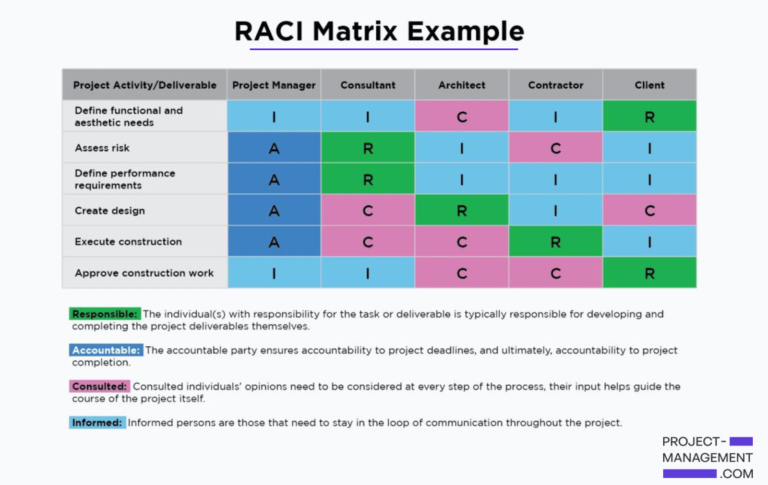
A RACI matrix helps break down what roles individuals will play as work is carried out and to what extent they will be involved in the project overall. The horizontal axis represents each person on the project team and the vertical axis represents each task.
Each square of the matrix represents an individual, a task, and that individual’s role within the project, either responsible, accountable, consulted, or informed.
In this situation, for example, the project manager is accountable for assessing risk, defining performance requirements, creating designs, executing construction, and approving construction work. However, they are only informed about approving construction work and defining functional and aesthetic needs.
Who Creates the RACI Matrix?
The RACI matrix — sometimes called RACI model, RACI diagram, or simply just RAC — is created by the project manager at the start of the project as a key part of establishing the initial human resources planning for the project.
Because miscommunication is a common threat to any project, RACI charts are a great asset to teams dealing with any type of work, from very simple projects to extremely complex ones.
Software Integration with Common PM Tools
Integrating the RACI Matrix into project management software makes it easier to assign roles and responsibilities. Here’s how the RACI Matrix works with popular tools:

Asana allows you to assign tasks and label roles like Responsible or Accountable directly in its project boards. By integrating RACI, project managers can easily track who is accountable for each phase, preventing miscommunication and task overlap. This tool also supports team collaboration by keeping all RACI role assignments visible in one place.

In Jira, RACI roles can be linked directly to project tickets. This integration helps project managers oversee who is accountable for each task while tracking the project’s progress through detailed reporting. Jira’s focus on issue tracking aligns perfectly with the RACI framework, ensuring that each decision and approval process is well-defined.

Trello utilizes labels and categories to represent RACI roles. With its simple, card-based format, project managers can visually assign and manage tasks, ensuring clarity on who is responsible or consulted at each stage. This tool is especially effective for smaller teams needing a clear overview of task assignments.
Integrating the RACI matrix into these tools enhances accountability and clarity, making it easier for teams to stay aligned on task responsibilities and avoid delays.
RACI Alternatives
While the RACI matrix is a widely used tool, several alternatives may be more suitable depending on your project’s needs:
- RASCI : Adds a Support role to the traditional RACI structure, providing extra assistance where necessary.
- DACI : The DACI framework focuses on decision-making by identifying clear Decision Makers and those accountable for final outcomes.
- RAPID : A decision-making framework that defines who Recommends, Agrees, Performs, Inputs, and Decides on critical decisions.
- Gantt chart : Provides a comprehensive view of who does what and when, combining responsibilities with timelines in a visual format.
- Work breakdown structure : Breaks down the entire scope of work in a project, offering a detailed view of all tasks in a hierarchical structure.
- Project dashboard : Offers dynamic, real-time oversight, keeping teams informed with up-to-date information on project progress, roles, and responsibilities.
Each RACI alternative differs on task ownership and project management. The best project managers choose the right approach based on their project’s needs.
RACI and Stakeholder Analysis
Stakeholder analysis is a crucial step that directly connects to the RACI matrix. By identifying all relevant stakeholders, project managers can effectively assign roles within the matrix.
This process helps clarify who has a vested interest in the project and ensures their roles are properly reflected in the matrix.
To run a stakeholder analysis:
- Identify key stakeholders : Determine who has a vested interest in the project’s success (e.g., clients, executives, team members).
- Define stakeholder influence : Assess how much influence each stakeholder has over project decisions.
- Align stakeholder roles with RACI : Assign stakeholders as Responsible, Accountable, Consulted, or Informed based on their role in the project.
- Maintain communication channels : Ensure stakeholders are appropriately informed of project progress, updates, and changes.
- Review regularly : Reassess stakeholder involvement as project phases evolve.
Aligning stakeholder involvement with RACI creates a roadmap for communication and decision-making that keeps everyone engaged and informed throughout the project life cycle.
Common Mistakes When Creating a RACI Matrix
- Failure to plan ahead : A RACI matrix should not be the first step in your project planning. Before preparing the matrix, ensure you have a fully assembled project team and a clear understanding of your project scope and key tasks. Without a basic structure in place, the matrix can become chaotic and difficult to manage. Starting with a rough project plan helps ensure that the RACI matrix aligns with your overall goals.
- Working with too large a team : The larger the team, the more complex the RACI matrix can become, leading to confusion rather than clarity. A matrix with too many roles or stakeholders can make responsibilities difficult to track and dilute accountability. For larger teams, consider breaking the project into smaller, manageable components, or you can use alternative frameworks. Between the DACI vs RACI model , DACI may be better at accommodating scale.
- Not communicating with the project team : A RACI matrix is meant to formalize responsibilities, not introduce them for the first time. Ensure that all team members are briefed on their roles and the project’s objectives before creating the matrix. Holding a kickoff meeting where tasks and responsibilities are discussed ensures everyone is aligned and prepared, preventing misunderstandings or confusion about their roles in the execution of the project.
- Overburdening team members : Assigning too many roles to a single person can lead to burnout and inefficiencies. If one team member is designated as both Responsible and Accountable for multiple tasks, they may become overwhelmed and unable to perform effectively. Regularly review the RACI matrix to ensure workload distribution is balanced and that no individual is shouldering too much responsibility.
- Hitting decision-making roadblocks : Without a clear assignment of who is Accountable for decision-making, tasks can get delayed as teams wait for approvals. This bottleneck can slow progress and create frustration. By explicitly identifying who has the authority to make final decisions, you ensure a smoother workflow and prevent key tasks from stalling due to indecision or unclear lines of accountability.
RACI Matrix Pros & Cons
- Increased engagement: RACI helps engage project participants throughout the project life cycle.
- Enhanced project planning: Project managers make project planning more organized, efficient, and detailed.
- Identifiable improvement opportunities: Areas of improvement are more easily identified.
- Easier collaboration: Use of a RACI matrix creates a clear path for leadership to sign off on project steps, as project documentation in the RACI model is heavily emphasized.
- Better communication: Improves overall group communication.
- Group accountability: Assists groups, especially larger project teams, stay connected and accountable to their roles and project goals.
- Limitations on role scope: The RACI model does not provide details on role scope, especially for responsible parties. These gaps in detail also affect other team roles; for example, the RACI model does not determine who is responsible for verification and signatory.
- Limits on task details and scope: While a RACI matrix can provide an overview of who is responsible for different tasks, it will not state what needs to be done.
- Not aligned to the agile methodology: Project managers using an agile methodology like scrum may find it redundant since accountability, ownership, and ongoing communication is built into the scrum framework (i.e., product owner, scrum master, and daily standups with the team). Additionally, agile focuses on team-based delivery and accountability, while the RACI framework and alternatives focus on individual responsibility and autonomous accountability.
Free RACI Matrix Templates
A number of project management software solutions include a native RACI matrix template. Here are just a few we found:
Colorful RACI chart template
We love this template from Smartsheet because it’s colorful, thorough, and includes room for every party involved in the project.

Pastel-colored RACI matrix template
This template from the Academy to Innovate HR is a great choice for project managers who want to organize their team roles with an easy-on-the-eyes chart that evolves beyond the simple spreadsheet.
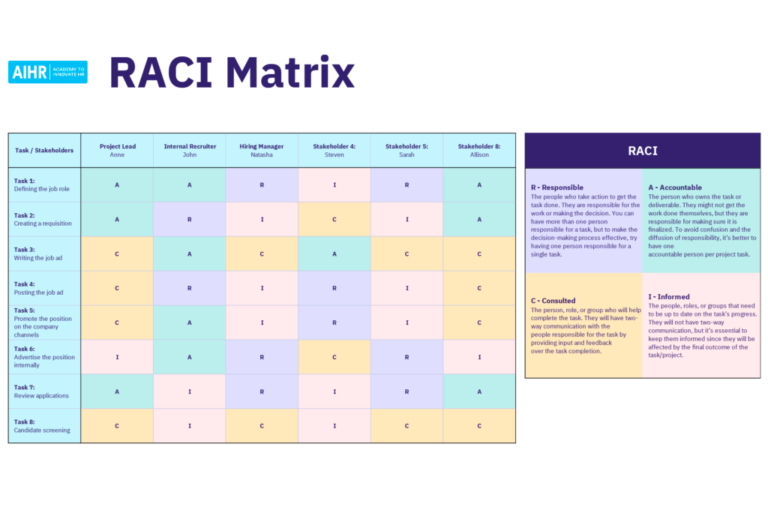
Simple RACI chart
These RACI templates from ClickUp have enough variety to fit any of your project needs, but are simple enough for even beginner PMs to use.
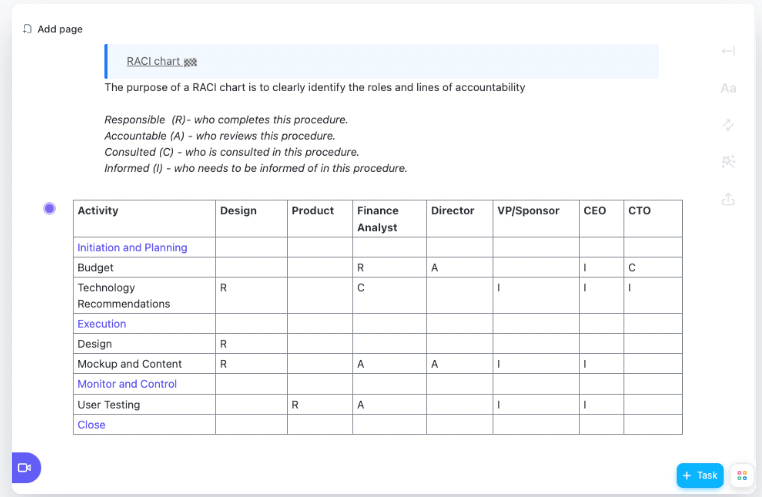
Detailed RACI matrix template
This template is a great starter template for anyone looking to explore RACI charts in their project management strategy. As an added bonus, it comes with the RACI definitions already built in!
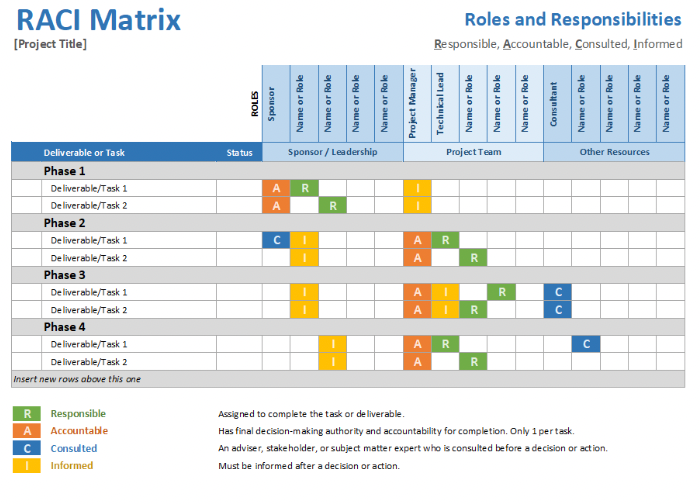
Excel-based RACI chart template
Are you an Excel or Google Sheets user looking to take advantage of the RACI matrix? An Excel-formatted template from Project Management Docs might just be the solution for you. This template is a great template for users who want a chart that comes in a preformatted structure.
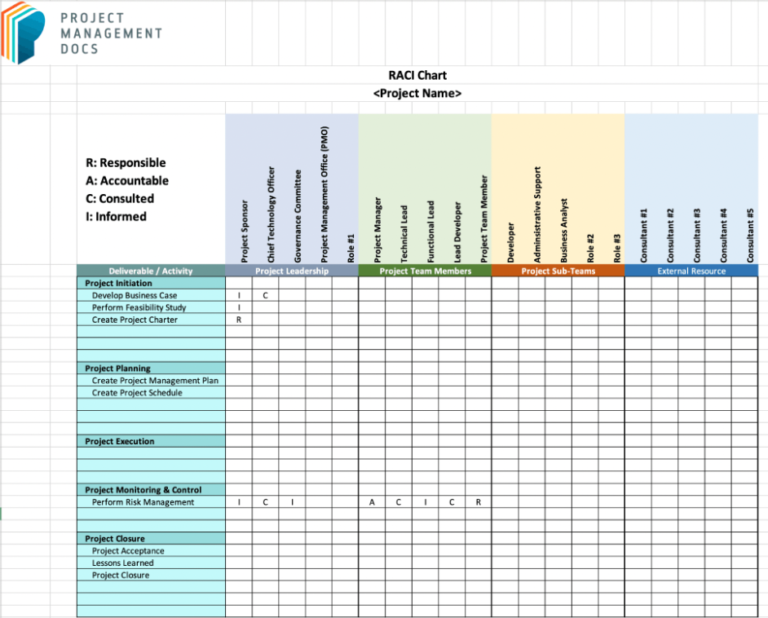
The four components of a RACI matrix are Responsible, Accountable, Consulted, and Informed. Responsible refers to the individual(s) who completes the task, while Accountable is the person who ensures the task is done. Consulted are those who provide input, and Informed are those who need to be updated on progress.
The difference between Responsible and Accountable lies in execution versus oversight. Responsible refers to the person who performs the work, while Accountable is the individual who ensures the task is completed successfully and takes ultimate ownership.
RACI is still widely used, but for more complex decision-making processes, alternatives like DACI and RAPID may be better suited. However, it remains a popular tool for establishing clear roles in projects, especially for smaller teams.
The Bottom Line on the RACI Matrix
The RACI matrix remains a powerful tool for defining roles and responsibilities in project management, helping teams avoid confusion and delays. By clearly assigning who is Responsible, Accountable, Consulted, and Informed, project managers can streamline communication, prevent decision-making bottlenecks, and ensure accountability.
While alternatives like RASCI or DACI exist, RACI is especially useful for smaller teams and simpler projects. When used correctly, it significantly enhances project clarity and efficiency, leading to smoother execution and more successful outcomes.
Join our newsletter
Subscribe to Project Management Insider for best practices, reviews and resources.
{{ TITLE }}
You should also read.

Business Process Management (BPM) vs Project Management Process (PM)

What is Smartsheet? 2024 Beginner’s Guide

Technical Project Manager (TPM) vs Project Manager (PM)

Get the Newsletter
You might also like.

DACI Decision-Making Framework: Everything You Need to Know
Risk Breakdown Structure (RBS) in Project Management Explained
AI in Project Management: Uses, Impacts, & 2024 Trends

IMAGES
VIDEO